- Green Living
- Health & Fitness
- Privacy Policy
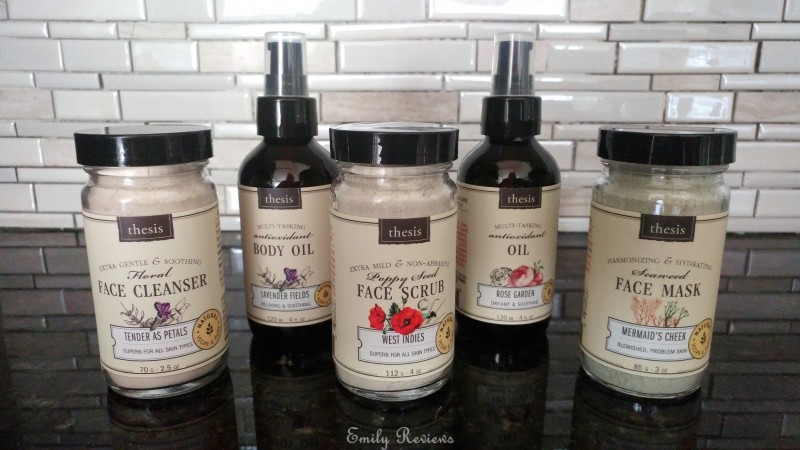
Thank you to Thesis Beauty for providing me with products to facilitate my blog review. All opinions are 100% my own.
Thesis Beauty specializes in organic and natural skin care products. Most of their products are made with food-grade ingredients. They have NO synthetics whatsoever! Each and every Thesis Beauty product has been crafted to have a unique aroma, beautiful natural color, and an attractive texture.
For my review, I received a Facial Mask Mermaid’s Cheek Seaweed, Facial Scrub West Indies Poppy Seed, Facial Cleanser Tender As Petals, Body Oil Rose Garden, and a Body Oil Lavender Fields Southern Blend.
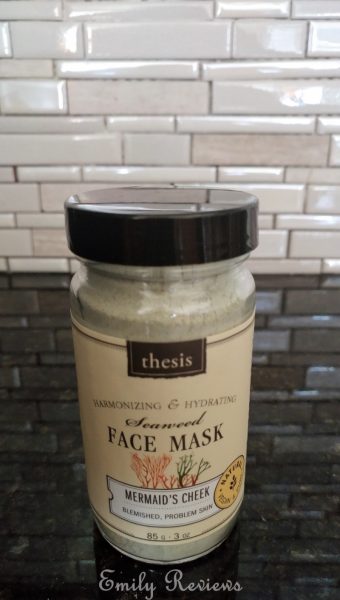
Facial Mask Mermaid’s Cheek Seaweed is made with Organic Sea Kelp, Natural Kaolin Clay, Natural French Green Clay, Organic Spinach, Organic Chlorella, and Organic Aloe Vera. Using Mermaid’s Cheek Seaweed will help cleanse, boots circulation, and remove impurities.
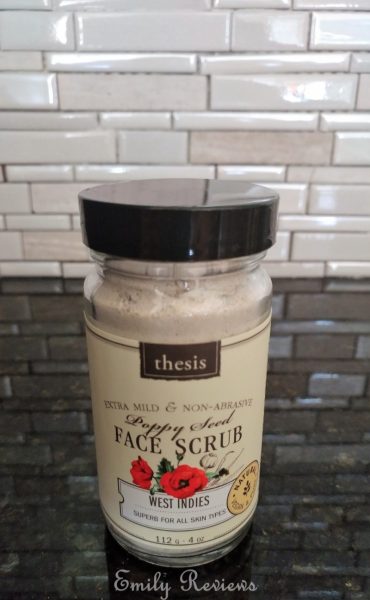
Facial Scrub West Indies Poppy Seed is designed to gently exfoliate, remove impurities, reduce excess oil, purify pores and revitalize your skin. It is made with Natural Kaolin Clay, Organic Poppy Seeds, Organic Rosehips, Organic Orange Peel, Organic Allspice, Natural French Green Clay, Natural Moroccan Rhassoul Clay, Natural Baking Soda, and Organic Cloves.
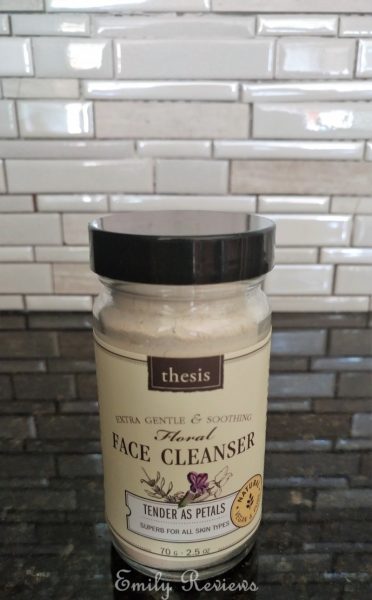
Facial Cleanser Tender As Petals has been crafted with Natural Premium Kaolin Clay, Organic Rose Flowers, Organic Chamomile Flowers, Organic Calendula Flowers, Organic Lavender Flowers, Organic Oats, and Natural Premium Moroccan Rhassoul Clay. Using Tender As Petals will leave your skin feeling clean, soft and rejuvenated.
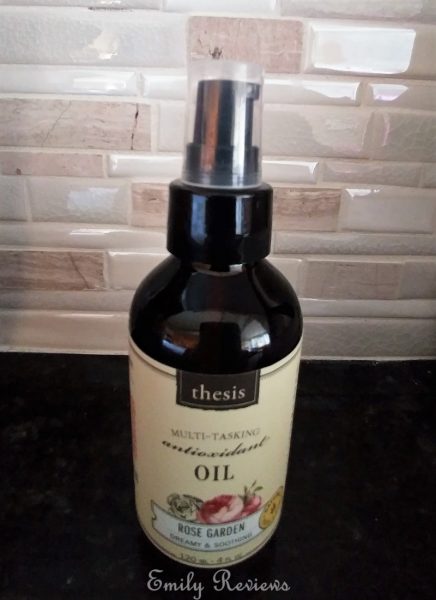
Body Oil Rose Garden was formulated to soothes and moisturize dry and rough skin. Rose Garden is made with Organic Soybean Oil, Organic Sunflower Oil, Organic Macadamia Oil, Organic Jojoba Oil, Organic Rosehip Oil, Organic Grapeseed Oil, Organic Rose Flavor Oil, Organic Palmarosa Essential Oil, and Organic Rosemary Antioxidant.
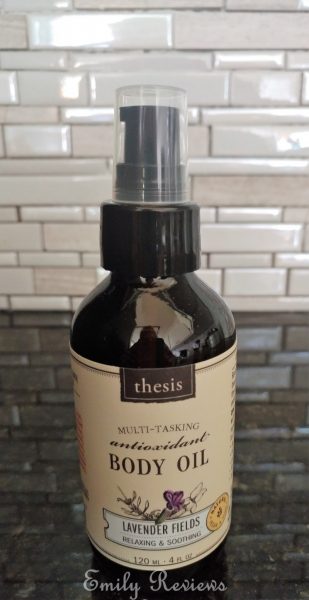
Body Oil Lavender Fields Southern Blend is made with Organic Soybean Oil, Organic Sunflower Oil, Organic Macadamia Oil, Organic Jojoba Oil, Organic Rosehip Oil, Organic Grapeseed Oil, Organic Lavender Essential Oil, Organic Sweet Orange Essential Oil, and Natural Vitamin E. Lavender Fields Southern Blend contains antioxidants and nutrients that are perfect for nurturing dehydrated damaged skin.
I have used Thesis Beauty products before and continue to be really impressed with them. I appreciate that they formulate their products with high-quality ingredients. I feel confident that when I use these products, I am doing something good for my skin and my health. I don’t have to worry about chemicals or other ingredients that could in some way harm me. I trust Thesis Beauty.
Buy It: Please visit the Thesis Beauty website to see the great selection of products they offer and convenient shopping locations.
Connect: Don’t forget to follow Thesis Beauty on Facebook , Twitter , and Pinterest for the latest product announcements and special offers.
Win It: One winner will receive a Facial Mask Mermaid’s Cheek Seaweed, Facial Scrub West Indies Poppy Seed, Facial Cleanser Tender As Petals, Body Oil Rose Garden, and a Body Oil Lavender Fields Southern Blend. This is a US giveaway and it is scheduled to end on 12/27/2017. Good luck.

Hello, my name is Laurie. My family and I live near the Oregon coast. When we aren’t at work, in school, or on the volleyball court, we enjoy traveling, cheering for our favorite sports teams, playing outdoors, and checking off items on our bucket list. We are lucky in that both sets of our parents, as well as our siblings and their families, live within an hour of us. We get together often to help one another out, celebrate milestones, and go on adventures together.
This post currently has 5 responses.
Those are the loveliest labels! Scrubs and oils and masks–everything you’d need!
I looked over this page at first but then went back to it. My daughter always talks about this stuff and i ran some of these by her and she loved them. She’d be so excited if she got to try these because dad can be clueless about this stuff sometimes 🙂 The bath salts look nice though. Thanks!
It looks very healthy.
Awesome giveaway 🙂 Thanks for the chance to win some natural beauty products. I have tried a few products from Thesis Beauty and loved them. I have yet to try the ones that you reviewed. My skin is dry since the weather is cold now so these would help my dry skin.
nice prize.

Leave a Reply Cancel Reply
Notify me of follow-up comments by email.
Notify me of new posts by email.

Current Giveaways
- Skip to main content
- Skip to secondary menu
- Skip to primary sidebar
- Skip to footer
Vegan and Fabulous!
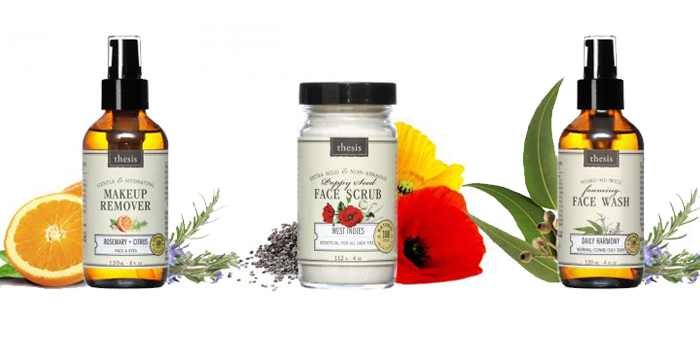
Get Glowing Skin with Thesis
August 9, 2017 By Robin
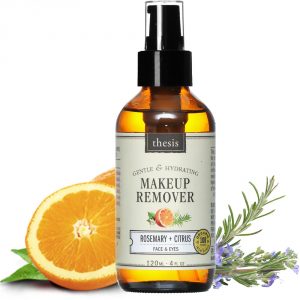
Let me start by telling you a few things about me, as the reviewer. I am at the tail end of the baby boomer generation. That gives you an idea of my age. And I still have oily skin. If you are way younger than me and you think you’ll outgrow this, I’m sorry to possibly burst your bubble. After many years of trying to find natural products that work on my skin, I finally have a daily regimen that I adore. Really adore. And it happens to include a Thesis product. I’ll get to that.
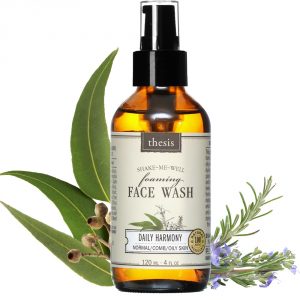
The uncompromised purity and opulent sensorial appeal of our products helped us win multiple awards in the organic and natural space. Each product is a spa-in-a-bottle experience with divine aromas, delectable textures, and captivating colors – all surprisingly organic and natural, no dirty chemistry involved!”
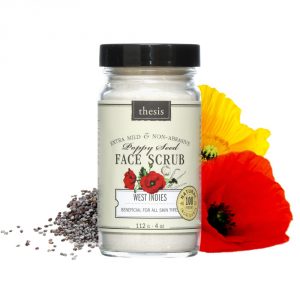
Next was the Rosemary & Citrus Makeup Remover . It’s an alluring blend of oils, it’s easy to use, and you don’t need much. In fact, that’s one thing I really love about all of these creations. They cost a bit more, but they are going to last.
Now for the cleanser. I tried the Balancing Face Wash Daily Harmony for normal, combination or oily skin (yeah!). I loved this. Most natural cleansers for oily skin contain some amount of tea tree oil, and I wasn’t surprised to find that in the ingredient list. While I appreciate the benefits of this essential oil, I do not like the way it smells. But the Balancing Face Wash also contains lavender, geranium and other oils, and the overall blend smells positively yummy. I applied it to dry skin, rubbed it in gently, then added water for some additional massaging – and also to get the foam action started. It was a invigorating experience, especially when the minty oils kicked in and my face woke up.
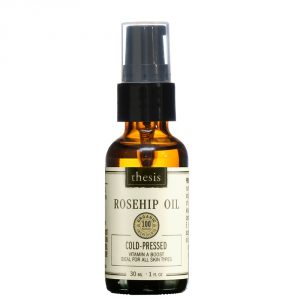
These are all standout offerings that deserve consideration for a spot in your skin-care regimen. Or, perhaps you want to try some of the company’s shower gels and bath soaps , or something from its home or baby collections. Shipping is free on orders over $75, and you get free samples with your order. Not a bad deal for great stuff.
About Robin
Robin Patalon has been vegan since 2011, after almost 20 years as a vegetarian. When she’s not working at her real job, she enjoys running, yoga, spending time with her family and educating herself about healthy living. Robin is a Certified Health Coach and a Vegan Lifestyle Coach and Educator. She is always on the lookout for new products and companies that support her vegan lifestyle and she has an extensive cookbook collection that is not digital.
Information on this website should not be interpreted as medical advice. Consult your physician for any medical conditions you may need assistance with.
Privacy Policy
See the Chic Vegan privacy policy .
Blog posts may contain affiliate links. Purchases made through affiliate programs help me keep this website running. Products may have been given to Chic Vegan contributors for review, but the opinions expressed on this website are their own. All written material and photographs are the copyright of the authors. Material and photographs from ChicVegan.com may not be repeated without written permission of the author.

Thesis Beauty Products
Have you been searching for beauty products that are vegan and cruelty free, natural and organic, and eco-friendly? Look no further! I personally use Thesis Beauty products and absolutely love them! Plus, Thesis has provided an exclusive discount just for you. 💚
I have also provided all of the links for you to purchase these products. While I am a Thesis Beauty affiliate, I fully stand by all products I endorse. I only promote products that I myself personally use on a regular basis– and love. By clicking on affiliate links, I may earn a small commission, at no additional cost to you. You can read more about affiliate links here .
About Thesis Beauty
Established in 2009, Thesis is a smaller, family-run company. Their mission: “to make a difference in the health of our customers and our environment through utmost purity, efficacy and accessibility of our products.”
Thesis uses premium certified organic and raw ingredients and no synthetics or fillers and needless chemical processes. Additionally, all products are certified vegan and cruelty free.
Not only do they pride themselves on natural, high quality skin care, the company also focuses on lessening its environmental impact. This includes not utilizing plastic whenever possible, sourcing only high quality, organic ingredients, and when available, using ingredients that are certified fair trade.
Thesis Beauty products are manufactured in the United States. And, they are produced in small batches by hand.

Thesis Beauty skincare includes face cleansers and moisturizers, shower gels and body creams, and deodorant.
Additionally, you can find products by skin type: oily, dry, combination, and sensitive skin.
Thesis also offers amazing gift sets . And no shame in buying these as a gift to yourself. 😉
In addition, several items are available in sample sizes . I love being able to try certain things first to make sure you really like them before purchasing larger sizes. That’s actually how I started my Thesis Beauty collection!
✅ At checkout, use code: PLANTBASED for your exclusive 15% discount! ✅
Thesis Beauty products I love and recommend

Face cleanser
Tender as Petals
Before trying Thesis, I only ever used liquid products on my face. It took a little getting used to in the beginning, but now I enjoy the process. Mix about 1 teaspoon of cleanser with water to make a paste in the palm of your hand. Then, wash as you normally would with cleanser. Additionally, it can also be left on the skin for 15-20 minutes as a mask.

Facial gel wash
Daily Harmony
This face wash is so refreshing and leaves the skin feeling amazing! With natural ingredients like tea tree, peppermint, lavender, and eucalyptus, you can’t go wrong!

West Indies
Exfoliates the skin nicely, without feeling like your face is going to burn off (you know what I’m talking about!) Plus, no plastic beads that are harmful to the environment .

Chocolate Heaven
This product is aptly named, because it truly does smell heavenly! Made from raw, unprocessed cacao, it soothes and nourishes the skin. Mix with water to make a paste and apply to the skin. Or, get creative and mix with oat milk, green tea, or citrus juice for an extra relaxing facial. Fair warning though: it will have you craving chocolate cake as you’re using it. 🤪

Facial moisturizer
Unscented serum .
I personally love some of the sensitive skin products for my face. They are unscented and not harsh on your skin. I wasn’t sure how I felt about oil as a moisturizer, but now I’m sold on it and truly love it! My skin feels amazing after cleansing and moisturizing with these products.

Patchouli
My favorite scented shower gel ever! Made with aloe vera and organic hemp oil, this shower gel leaves your skin feeling refreshed and hydrated.

Patchouli Decadence Antioxidant Cream
This body cream is probably my favorite product from Thesis. It is the most beautiful scent and hydrates the skin incredibly well. Plus, a little goes a long way, so this is worth the splurge!
For even more vegan beauty products, be sure to check out last year’s Black Friday article.
Do you use any Thesis Beauty products? Which ones are you excited to try? Let me know in the comments below!
👉 And remember to use our code at checkout to receive 15% off your purchase. Code: PLANTBASED
Happy shopping! 🛍

Share this:
2 thoughts on “thesis beauty products”.
I wish I would have used non-chemical skincare products when I was much younger. Apparently I’m the the “mature” skin group! And at an era that sun-abused my skin! UGH!!!! I’m going to try the deodorant. I have tried many different brands and mostly don’t work. But it’s better than using the chemical-aluminum-based brands. And trying the facial recovery serum. One thing I don’t like is oily skin after I’ve applied moisturizer. Especially at bedtime when I feel like I’m sticking to the pillow! Can’t wait to see how I like them. Thank you!!
How wonderful we now use words like “mature” to describe certain age groups! 😂 Finding a natural deodorant that actually works is really difficult. I think sometimes too our bodies have been so conditioned to certain chemicals and ingredients for so long that it takes a long time for anything natural to take effect. I hope this deodorant works for you! I personally love their skincare products, so I hope you do too! And with Thesis products, a little goes a long way, so you definitely feel like you get your moneys worth. Thanks for trying! Hope you enjoy! 💚
Leave a Comment Cancel Reply
Your email address will not be published. Required fields are marked *
Save my name, email, and website in this browser for the next time I comment.
Notify me of follow-up comments by email.
Notify me of new posts by email.

- Beauty & Personal Care
- Treatments & Masks

Image Unavailable

- To view this video download Flash Player
Organic Facial Recovery Serum - Nourishing Smoothing Replenishing Moisturizer for Dry, Mature and Dehydrated Skin with Pomegranate Antioxidants, Argan, Grapeseed, Rosehip Oils
About this item.
- 99% Certified Organic Ingredients - the highest organic percentage
- No Preservatives, no chemicals, synthetics or cheap fillers - regular lotions are 70% water
- #1 for dry, mature, dull, damaged skin
- 10 star certified organic oils, including rare Moroccan Argan & Macadamia oils - nourish with antioxidants, fight free radicals & signs of premature aging
- Goes perfectly under makeup and has divine herbal aroma - 1 fl.oz / 30 ml

Customers also viewed these products

PRODUCT CERTIFICATIONS (2)
EWG Verified products are reviewed to ensure they are free from EWG’s known chemicals of concern and adhere to strict health standards.
USDA Organic products are grown and processed according to the USDA Organic standards addressing soil and water quality, among other factors. Organic is protected by law, inspected by experts, traced from farm to store, and shaped by public input.

PRODUCT CERTIFICATION (1)

Product Description

Nourishing and Moisturizing Recovery Face Serum for Dry, Mature and Dehydrated Skin

This organic facial serum contains truly luxurious oils, such as Moroccan argan oil, grapeseed, rosehip and jojoba - all loaded with powerful antioxidants and natural vitamins to support youthful, glowing appearance. Unlike many products on the market today, it hasn't been watered down or filled with cheap substitutes, preservatives and emulsifiers. Every ingredient is used in a generous proportion to allow for the best, fastest results in nurturing and restoring your skin.
Cold-pressed, unrefined, raw organic Argan oil is a premium ingredient valued for its nutritive and cosmetic properties. It is considered to be one of the rarest oils in the world due to very small and specific growing area in Morocco. It's extremely rich in natural vitamin E, A, B1, B2, B6, C, minerals, carotenes, antioxidants, essential fatty acids, and saponins (which soften the skin).
Organic Grapeseed oil, being a great moisturizer abundant in antioxidants and vitamins, such as vitamin A, B, C, E, promotes skin radiance and helps fight signs of premature aging inflicted by environment.
Cold-pressed, raw, unrefined organic rosehip oil is truly amazing and is believed today to be one of the best natural oils for the skin. It helps skin to regain its natural smooth and glowing appearance.
Turn your glowing, beautiful complexion on and never go back to dull, dry skin!

Product details
- Is Discontinued By Manufacturer : No
- Product Dimensions : 1.3 x 1.3 x 4.2 inches; 1 ounces
- Item model number : fc-ser-dryskn-1floz
- UPC : 856367002139
- Manufacturer : Thesis Beauty
- ASIN : B0036JLJ2K
Important information
Ingredients.
Organic Jojoba Oil; Organic Sunflower Oil; Organic Argan Oil; Organic Grapeseed Oil; Organic Macadamia Oil; Organic Rosehip Oil; Organic Pomegranate Extract; Natural Vitamin E Complex, Soy-free D-alpha, beta, gamma, delta Tocopherols and Tocotrienols); Organic Palmarosa Essential Oil; Organic Patchouli Essential Oil; Organic Geranium Essential Oil; Organic Orange Essential Oil; Organic Rosemary Extract
Looking for specific info?
Customer reviews.
Customer Reviews, including Product Star Ratings help customers to learn more about the product and decide whether it is the right product for them.
To calculate the overall star rating and percentage breakdown by star, we don’t use a simple average. Instead, our system considers things like how recent a review is and if the reviewer bought the item on Amazon. It also analyzed reviews to verify trustworthiness.
Customers say
Customers like the effect of the skin serum. They mention it's good for the skin, makes it super soft, and helps heal it. They also say it helps calm down skin reactivity, nourishes and protects it. Customers are also impressed with the quality, saying it'll last a long time and is perfect. They appreciate the wonderful smell.
AI-generated from the text of customer reviews
Customers are happy with the effect of the skin serum. They say it's good for their skin, makes their skin super soft, and helps heal it. They also say it helps to calm down their skin reactivity, nourishes and protects it. Customers also mention that it'd be excellent for dry skin. They love the smell and say it doesn't leave their skin feeling greasy.
"...The serum helps me to calm down my skin reactivity, nourishes and protects ( people with dry skin normally have a disrupted lipid layer), restores..." Read more
"This is an excellent oil for dry skin . It has a pronounced citrusy/patchouli scent as you apply it on your face but it fades a little." Read more
"...My rosacea isn't nearly as bad as it was when I moved out, my skin feels soft and smooth , and it doesn't leave my skin feeling greasy once it sinks..." Read more
"...extremely dry skin and in just a little over a week, my skin has become completely hydrated ...." Read more
Customers are satisfied with the quality of the skin serum. They mention it's excellent, perfect, and pleasant to use. They also say a little goes a long way and their skin looks radiant after using it.
"... My skin looks radiant and there's is no oily residue. After applying on my face, I rub the remaining oil on my hands and they look amazing as well...." Read more
"...A reasonable price, a little goes a long way, pleasant to use and it won't over strip your skin so you need more products. Love this company!" Read more
"...It smells nice and feels so good going on ....I always feel like I'm giving my face a "treat" when I smooth it on - I just love it!!..." Read more
"... Absolutely perfect and a lifesaver in winter." Read more
Customers are satisfied with the smell of the skin serum. They mention it has a wonderful smell and is amazing value for quality.
"This is an excellent oil for dry skin. It has a pronounced citrusy/patchouli scent as you apply it on your face but it fades a little." Read more
"...I will definetly will order again, it has a wonderful smell , and again a little bit goes a long way." Read more
"The serum feels wonderful and makes your skin super soft and I love the smell . This is what skin care should be...." Read more
"...It smells nice and feels so good going on....I always feel like I'm giving my face a "treat" when I smooth it on - I just love it!!..." Read more
- Sort reviews by Top reviews Most recent Top reviews
Top reviews from the United States
There was a problem filtering reviews right now. please try again later..
Disclaimer : While we work to ensure that product information is correct, on occasion manufacturers may alter their ingredient lists. Actual product packaging and materials may contain more and/or different information than that shown on our Web site. We recommend that you do not solely rely on the information presented and that you always read labels, warnings, and directions before using or consuming a product. For additional information about a product, please contact the manufacturer. Content on this site is for reference purposes and is not intended to substitute for advice given by a physician, pharmacist, or other licensed health-care professional. You should not use this information as self-diagnosis or for treating a health problem or disease. Contact your health-care provider immediately if you suspect that you have a medical problem. Information and statements regarding dietary supplements have not been evaluated by the Food and Drug Administration and are not intended to diagnose, treat, cure, or prevent any disease or health condition. Amazon.com assumes no liability for inaccuracies or misstatements about products.
- Amazon Newsletter
- About Amazon
- Accessibility
- Sustainability
- Press Center
- Investor Relations
- Amazon Devices
- Amazon Science
- Start Selling with Amazon
- Sell apps on Amazon
- Supply to Amazon
- Protect & Build Your Brand
- Become an Affiliate
- Become a Delivery Driver
- Start a Package Delivery Business
- Advertise Your Products
- Self-Publish with Us
- Host an Amazon Hub
- › See More Ways to Make Money
- Amazon Visa
- Amazon Store Card
- Amazon Secured Card
- Amazon Business Card
- Shop with Points
- Credit Card Marketplace
- Reload Your Balance
- Amazon Currency Converter
- Your Account
- Your Orders
- Shipping Rates & Policies
- Amazon Prime
- Returns & Replacements
- Manage Your Content and Devices
- Recalls and Product Safety Alerts
- Conditions of Use
- Privacy Notice
- Consumer Health Data Privacy Disclosure
- Your Ads Privacy Choices
We’re independently supported by our readers and we may earn a commission when you buy through our links.
What are you looking for?
Search ideas for you, thesis nootropics review.
Sheridan Grant
Content Specialist
Sheridan is a writer from Hamilton, Ontario. She has a passion for writing about what she loves and learning new things along the way. Her topics of expertise include skincare and beauty, home decor, and DIYing.
Table of Contents
About Thesis Nootropics
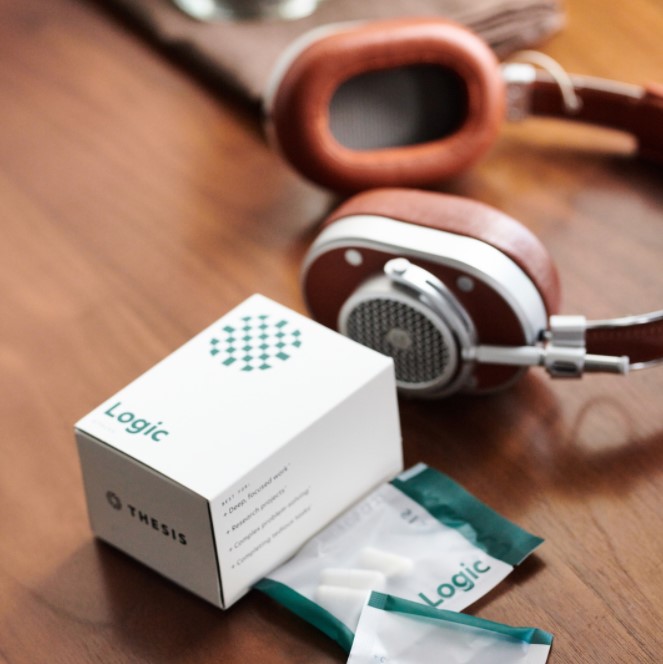
Hands up if you guzzle five coffees a day to stay awake, have tried all the supplements in the book desperate to improve your headspace, and aren’t interested in prescribed medications. Designed to increase focus , Thesis nootropics might be for you.
Thesis offers a customized blend of ingredients designed to optimize your cognitive function , with personalized details that tackle your specific needs. Nootropics boost brain performance in the same way a stimulant would, without the common negative effects.
A study published in the Journal of Alzheimer’s Disease found that nootropics may help improve cognitive function in people with Alzheimer’s disease.
Interested in finding out more about the brand and how it works? Leaf through our Thesis Nootropics review. We’ll be your guide through the company and the process, as well as details on the treatments, highlights from customer reviews, answers to important FAQs, and more, to help you decide if it’s worth the try.
Pros and Cons

- Multiple cognitive benefits: Thesis Nootropics offers a variety of blends that cater to multiple aspects of cognitive function.
- Long-term effects: On top of short term benefits for daily life, Thesis nootropics ingredients are designed to impact the brain in the long-term.
- Personalized recommendations: Thesis Nootropics makes personalized recommendations based on your goals and unique brain chemistry.
- Potential side effects: The most common side effects to watch out for when you start taking Thesis Nootropics include heartburn, headaches, confusion, dizziness, loss of appetite, and digestive issues.
- Need to stop taking if issues arise: If you experience a headache or an upset stomach that won’t go away while taking their nootropics, Thesis recommends that you stop taking them.
What is Thesis Nootropics?
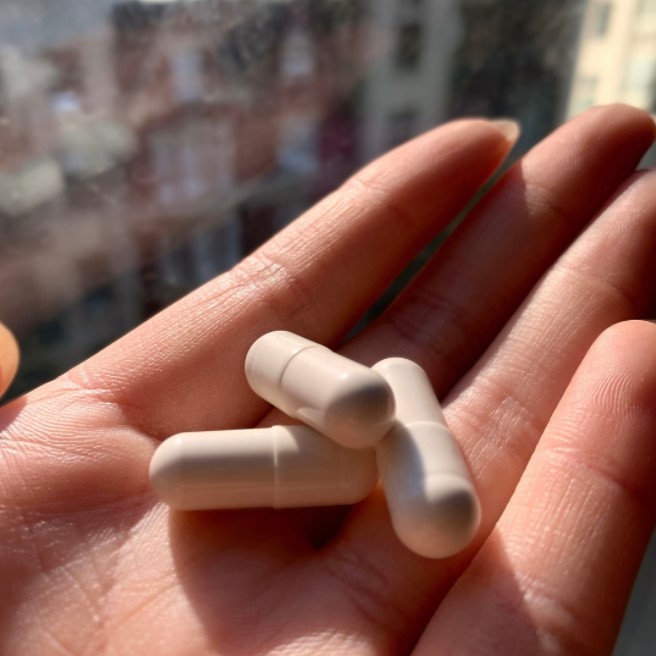
Nootropics are nutrient compounds and substances that are known to improve brain performance , such as caffeine and creatine. They help with issues that affect motivation, creativity, mood, memory, focus, and cognitive processing.
Nootropics are the ideal addition to an already healthy lifestyle that consists of exercise, proper nutrition, and enjoyable activities. Thesis nootropics are carefully formulated to target specific needs, ranging from energy to creativity. The brand focuses on safety, ensuring that all supplements adhere to FDA guidelines and go through multiple clinical trials.
How Thesis Nootropics Works

With all that being said, you may be wondering how Thesis provides users with an option that is specific to their needs. Fortunately, the process is simple and hassle free. Here’s how it works:
- Take the Thesis nootropics quiz
- Answer questions about your basic information
- Receive personalized recommendations
- Get your starter kit for $120 , or $79 monthly when you subscribe
After that, you’ll select one formula to take each week, taking one day off in between each different option. You’ll also track your results in the daily journal over the month to see how they affect your daily life.
From there, it operates as a subscription service. Users will be able to optimize their next shipment by telling the brand which formulas worked best.
If you don’t like any of the blends in your box, let the company know and they’ll switch it for something that’s a better fit for your lifestyle, genetics, and goals.
Thesis Nootropics Ingredients
Thesis Nootropics is a brand that offers personalized nootropics designed to enhance cognitive function and overall brain health. Their blends contain a variety of ingredients that are carefully chosen for their cognitive-boosting properties. Here are some of the key ingredients in Thesis Nootropics:
- Cognizin (Citicoline) : Cognizin is a type of choline that is known for its ability to enhance cognitive function, including memory and focus.
- L-Theanine : L-Theanine is an amino acid that is found in green tea, and is known for its ability to promote relaxation and reduce stress and anxiety.
- Lion’s Mane Mushroom : Lion’s Mane Mushroom is a type of medicinal mushroom that is believed to have cognitive-boosting properties, including improved memory and focus.
- Rhodiola Rosea : Rhodiola Rosea is an adaptogenic herb that is known for its ability to reduce stress and fatigue, and improve mental clarity and cognitive function.
- Ashwagandha : Ashwagandha is an adaptogenic herb that is known for its ability to reduce stress and anxiety, and improve memory and cognitive function.
- Phosphatidylserine : Phosphatidylserine is a type of phospholipid that is found in high concentrations in the brain, and is believed to support cognitive function, including memory and focus³
- Alpha-GPC : Alpha-GPC is a type of choline that is known for its ability to enhance cognitive function, including memory and focus.
- TAU (uridine): TAU is a blend of uridine, choline, and DHA, which is believed to support brain health and cognitive function.
- Artichoke extract : Artichoke extract is believed to enhance cognitive function by increasing levels of acetylcholine, a neurotransmitter that is important for memory and learning.
- Dynamine : Dynamine is a type of alkaloid that is believed to enhance cognitive function by increasing levels of dopamine, a neurotransmitter that is important for mood and motivation.
Overall, the ingredients in Thesis Nootropics are carefully chosen for their cognitive-boosting properties, and are designed to work together to enhance overall brain health and cognitive function.
Thesis Nootropics Health Benefits
Thesis Nootropics is a brand that offers personalized nootropics designed to enhance cognitive function and overall brain health. Their blends contain a variety of ingredients that are carefully chosen for their cognitive-boosting properties, and offer numerous health benefits. Here are some of the health benefits of Thesis Nootropics:
- Increased cognitive energy : One of the key benefits of Thesis Nootropics is increased cognitive energy, which can help improve productivity, mental alertness, and motivation, as it contains cognizin .
- Enhanced mental clarity : Another benefit of Thesis Nootropics is enhanced mental clarity,given from Lion’s Mane Mushroom which can help reduce brain fog and improve focus.
- Improved memory and learning abilities : Thesis Nootropics contains ingredients that are believed to improve memory and learning abilities, like Phosphatidylserine , which can help users retain information more effectively.
- Elevated mood : Thesis Nootropics may help elevate mood and reduce symptoms of anxiety and depression, thanks to ingredients like L-Theanine and Ashwagandha .
- Lowered stress levels : The adaptogenic herbs in Thesis Nootropics, such as Rhodiola Rosea and Ashwagandha , are known for their ability to lower stress levels and promote relaxation.
- Boosted focus : Thesis Nootropics contains ingredients like Alpha-GPC and Artichoke extract , which are believed to boost focus and concentration.
While Thesis Nootropics offers numerous health benefits, it’s important to note that the long-term effects of nootropics are not yet fully understood and more research is needed.
3 Thesis Nootropics Bestsellers
Thesis energy review.

If you’re constantly struggling to keep up with the demands of your busy life, it might be time to try a natural energy booster like Thesis Energy. This powerful nootropic blend is specifically designed to increase energy, overcome fatigue, and build mental stamina.
Thesis Energy is caffeine-free, making it a great option for those who are sensitive to caffeine or looking for a natural alternative to traditional energy drinks. The Energy formulation is designed to help improve focus and mental clarity, increase cognitive energy, and reduce fatigue. Whether you’re facing a busy day at work, recovering after a night of poor sleep, or gearing up for an intense workout, Thesis Energy can help you power through.
Each ingredient in Thesis Energy is carefully chosen for its energy-boosting properties. The specific ingredients can vary depending on your needs, but they work together to help increase energy, improve mental clarity, and reduce fatigue.
To get the most out of Thesis Energy, take it every morning on an empty stomach. You can also take it again after lunch if you need an extra boost. It’s designed to help you tackle busy, hectic days, recover from poor sleep, and power through intense workouts.
If you’re tired of relying on coffee and energy drinks to get through the day, it might be time to give Thesis Energy a try. Check availability and start boosting your energy naturally today!
Thesis Creativity

If you’re someone who struggles with creativity or finds yourself feeling stuck in your creative endeavors, Thesis Creativity may be worth considering. This nootropic supplement is designed to help spark inspiration, enhance verbal fluency, and boost confidence in your own great ideas.
So what’s in Thesis Creativity? The ingredients may vary depending on your specific needs, but these ingredients work together to support stress management, memory function, mood regulation, and energy production.
By supporting stress management, memory function, and mood regulation, Thesis Creativity can help free up mental space for more creative thinking. Additionally, the caffeine and L-theanine combo can provide a boost of energy and focus without the jitters and crash that can come with caffeine alone.
To get the most out of Thesis Creativity, it is recommended to take it every morning on an empty stomach and again after lunch if you need an extra boost. This nootropic blend is particularly helpful for brainstorming and creative thinking, writing and creative projects, and public speaking and social situations.
As with any nootropic supplement, it’s important to note that the long-term effects of Thesis Creativity are not yet fully understood and more research is needed. It’s always a good idea to speak with a healthcare professional before adding any new supplements to your routine.
In summary, if you’re looking for a little extra help in the creativity department, Thesis Creativity may be a valuable addition to your nootropic lineup. Its unique blend of ingredients can help support mental clarity, mood regulation, and energy production, making it a valuable tool for any creative individual.
Thesis Logic

If you’ve been having trouble with your memory lately, such as forgetting what you had for lunch yesterday or struggling to recall common words, then Thesis Logic may be just what you need. This formula is designed to help enhance your processing speed, boost your memory, and deepen your thinking.
Thesis Logic is caffeine-free, making it a great option for those who are sensitive to caffeine. The formula is ideal for use during deep, focused work, complex problem-solving, research projects, and completing tedious tasks.
Taking Thesis Logic is easy – simply take it every morning on an empty stomach, and take it again after lunch if you need an extra boost. By incorporating Thesis Logic into your daily routine, you may notice improvements in your cognitive function and overall mental performance.
Who Is Thesis Nootropics For?
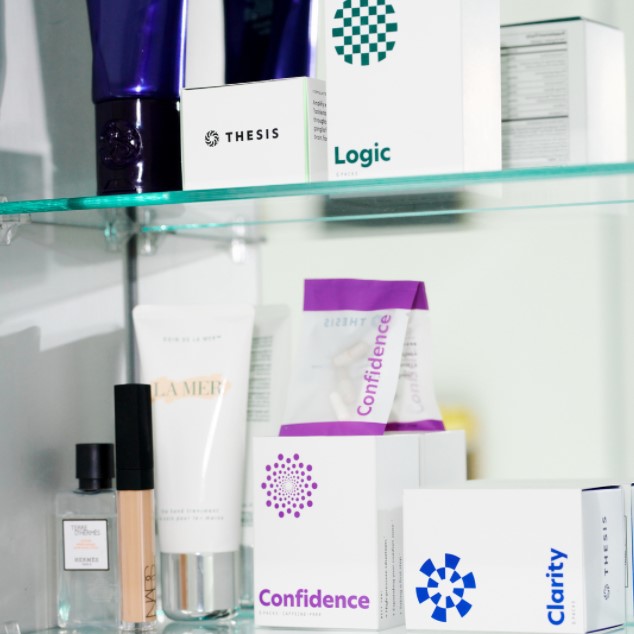
Thesis nootropics are designed for a number of different specific needs, including anyone who wants to focus better, have more energy, and maintain mental clarity. All in all, the products are specifically formulated to improve day to day life and target your specific needs .
Thesis Nootropics Side Effects

While Thesis nootropics are designed to enhance cognitive performance and provide a range of benefits, it’s important to be aware of the potential side effects that can occur. As with any supplement, individual reactions can vary, and some people may experience side effects while others may not.
Some of the potential side effects of Thesis nootropics include:
- Insomnia : Some nootropics contain caffeine or other stimulants that can disrupt sleep patterns and lead to difficulty falling asleep or staying asleep.
- Blurry vision : Certain nootropics, such as those containing alpha GPC, have been linked to temporary blurry vision.
- High blood pressure : Stimulant-based nootropics can increase blood pressure, which can be dangerous for people with hypertension or other heart conditions.
- Fast heart rate : Similarly, stimulants can also increase heart rate, leading to palpitations or a rapid pulse.
- Circulation problem s: Certain nootropics, such as vinpocetine, can affect blood flow and circulation, leading to issues like dizziness, nausea, or headaches.
- Addiction : Some nootropics, such as those containing racetams, have been associated with the potential for addiction or dependence if used long-term.
It’s important to remember that not all nootropics will produce these side effects, and the severity of any reactions will depend on individual factors such as dosage, duration of use, and underlying health conditions. However, it’s always wise to discuss any potential risks with a healthcare professional before starting any new supplement regimen.
Additionally, it’s important to follow dosage instructions carefully and not to exceed recommended amounts, as this can increase the risk of side effects. By being mindful of potential risks and using nootropics responsibly, users can reap the benefits of these supplements without experiencing adverse effects.
Thesis Nootropics Reviews: What Do Customers Think?

At this point in our Thesis nootropics review, it’s time to turn to what customers are saying. So, we sourced testimonials from the brand’s website, Reddit, and ZenMasterWellness. And spoiler alert, the Thesis nootropics reviews we came across have nothing but good things to say.
On takethesis.com , the brand earns 4.4/5 stars out of 7,956 reviews. One patron describes their particular blend as the perfect alternative to prescription meds :
“ I have been off stimulants for months now and these formulas are far superior. My husband and daughter both noticed the change and said I have been more productive, focused, less anxious, and more “thinking outside the box”. I have tried for years to get off stims and nothing would work .”
On Reddit, many reviewers share similar sentiments about how effective the products are. One buyer shares that they tried tons of different nootropics on the market, and Thesis stands out amongst the crowd .
On ZenMasterWellness, one reviewer states that their blend provided the exact results they were looking for :
“ They offer notable improvements to how well I’m able to focus, stay on task, and grind when it’s time to grind. In practice, this usually looks like a clearer mind and an improved ability to just… chill. With the Clarity and Creativity blends, in particular, I just feel leveled out .”
Backed by clinical trials and real customer experiences, Thesis stands out in the world of nootropics and supplements. The personalized selections prove effective, while the quality ingredients live up to expectations.
Is Thesis Nootropics Legit?

If you’re wondering if this brand offers products that are too good to be true, this Thesis nootropics review is here to say that it is the real deal .
The brand is backed by numerous clinical trials, which highlight how 86% of customers reported improvements in a wide range of cognitive challenges, while 89% noticed an improvement in their ability to reduce stress and maintain energy.
Is Thesis Nootropics Worth It?

Thesis is an appealing choice in the world of nootropics because it provides a completely customized selection based on your needs and goals. Plus, the ingredients are potent and ensure the best effects—and you only end up paying for the benefits you actually need.
With that in mind, this Thesis nootropics review deems the brand worth the try.
Alternatives
Here are some alternatives to Thesis Nootropics that you might find interesting:
- Mind Lab Pro – This nootropic supplement is designed to improve cognitive function and mental performance. It contains 11 ingredients that work together to enhance memory, focus, and overall brain health.
- Thorne Supplements : If you’re looking for high-quality, science-based supplements, Thorne is a great choice. Their products are designed with the latest research in mind and are rigorously tested for quality and purity. Some of their popular offerings include multivitamins, protein powders, and omega-3 supplements.
- WeAreFeel Supplements : WeAreFeel is a supplement brand that offers a variety of products designed to support different aspects of your health. Their supplements are vegan-friendly and free from artificial colors, flavors, and preservatives. Some of their popular offerings include multivitamins, probiotics, and omega-3 supplements.
- Neuro Gum : If you’re looking for a quick and easy way to boost your focus and energy levels, Neuro Gum is a great option. This gum is infused with caffeine and other natural ingredients that can help improve mental clarity and alertness. Plus, it’s sugar-free and comes in a variety of delicious flavors.
- Neuriva Plus : Neuriva Plus is a brain supplement that’s designed to improve memory, focus, and cognitive performance. It contains a blend of natural ingredients, including coffee fruit extract and phosphatidylserine, that have been shown to support brain health. If you’re looking for a natural way to boost your cognitive function, Neuriva Plus is worth considering.
Thesis Nootropics Promotions & Discounts
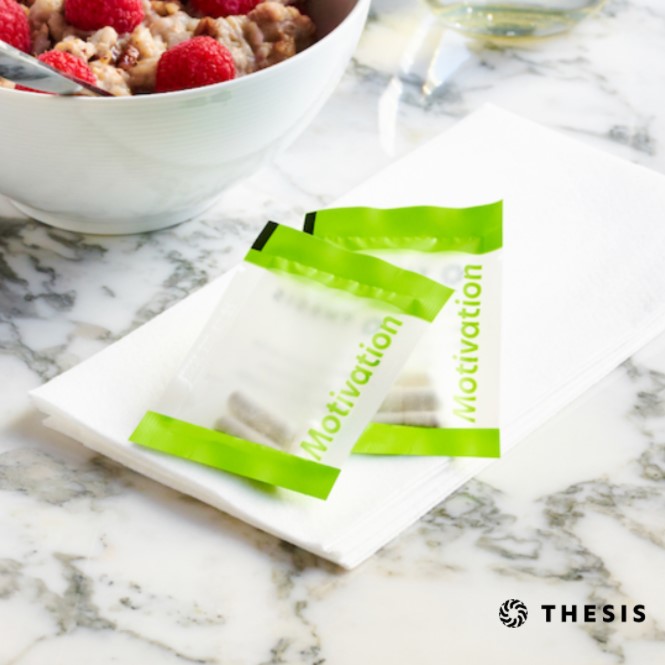
There aren’t currently any Thesis promos or discounts available. That being said, if you subscribe for recurring shipments of your recommended products, you’ll save $40 monthly .
Where to Buy Thesis Nootropics

At the time of this Thesis nootropics review, the products are exclusively available on the brand’s website, takethesis.com .
Is Thesis Nootropics vegan?
Thesis nootropics are made with only vegan ingredients . That being said, while the brand has taken precautions to protect against cross contamination, the products are not certified vegan.
Is Thesis Nootropics gluten-free?
On top of being vegan, Thesis products are made without gluten, eggs, or nuts . Again, while the brand strives to protect users against cross contamination, the products are not certified gluten free.
What is Thesis Nootropics’ Shipping Policy?
If you’re anxiously awaiting your order from this Thesis nootropics review, you’ll be happy to hear that the company offers speedy shipping, sending orders out within 1 business day. After that, packages should arrive within only 1-3 business days . Costs are calculated at checkout.
At this time, Thesis is not able to offer international shipping. This Thesis nootropics review recommends following the brand on social media and signing up for the newsletter to stay up to date with shipping policies.
What is Thesis Nootropics’ Return Policy?
If you find that your Thesis formula isn’t working out, the company requests that you contact them to make changes and adjustments to ensure you are able to receive the proper help.
If you would still like to make a return, follow these simple steps for a refund:
- Submit your refund request
- Ship the items back within 30 days of the original delivery
- Send an email with your tracking number to the brand
- Return any remaining product in their original packaging to:
Thesis Returns 902 Broadway
6th Floor New York, NY
Once your return has been received, a refund will be processed and email confirmation will be sent. It’s also important to note that the brand can only refund one month’s supply per customer and return shipping is the customer’s responsibility.
How to Contact Thesis Nootropics
We hope you enjoyed this Thesis nootropics review! If you have any further questions about the brand or its products, you can contact them using the following methods:
- Call 1 (646) 647-3599
- Email [email protected]
902 Broadway Floor 6 New York, NY 10010
If you’re looking for other ways to boost your productivity via supplements, check out these other brands we’ve reviewed:
Thorne Supplements Review
WeAreFeel Supplements Review
Neuro Gum Review
Neuriva Plus Review
Our team is dedicated to finding and telling you more about the web’s best products. If you purchase through our links, we may receive a commission. Our editorial team is independent.
Ask the community or leave a comment
Customer reviews, leave a review, ask the community or leave a comment cancel reply.
Your email address will not be published. Required fields are marked *
This field is required
This field is required Please use a valid email
Save my name, email, and website in this browser for the next time I comment.
You may also be interested in

Location & Hours
Suggest an edit
425 S Orange St
Missoula, MT 59801
You Might Also Consider

Meadowlark Electrolysis
0.5 miles away from Thesis
Offering the only FDA-approved treatment for permanent hair removal in the Missoula area! Providing the most up-to-date technology and training for greater efficiency and smoother results - call for a consultation today and we can… read more
in Hair Removal

Rejuvecare Medical Spa & Clinic
1.8 miles away from Thesis
Imagination, Innovation, Rejuvenation! RejuveCare Medical Spa & Clinic was founded on the idea that corrective treatments need to be performed in a warm and inviting space to truly be effective. Our approach combines medical… read more
in Medical Spas, Laser Hair Removal, Skin Care

RS Aesthetics
Lyn K. said "If I could give Rosalee 50 stars I would. She is professional and well educated in her field. I started with Rosalee 6 years ago. I moved away and tried other injectors but no one matched Rosalee's skills. I missed her so much I…" read more
in Cosmetic Surgeons, Medical Spas, Skin Care
Amenities and More
5 More Attributes
About the Business
Business owner information
Business Owner
Thesis is a small skincare studio in the heart of Missoula, Montana. We approach your skin with the goal of creating truly, deeply, healthy skin. Our goal is not to alter your skin, our goal is to nourish and support it. …

Ask the Community
Ask a question
Yelp users haven’t asked any questions yet about Thesis .
Recommended Reviews
- 1 star rating Not good
- 2 star rating Could’ve been better
- 3 star rating OK
- 4 star rating Good
- 5 star rating Great
Select your rating
Overall rating

Lauren gave me the most relaxing, and nourishing facial I've ever had! My skin was literally glowing afterwards and I had the same euphoric feeling I get after a great massage. Her spa area was so peaceful and lovely with a warming table and lovely soft sheets. She's a master aesthetician and after checking in with me about my current skincare routine she knew exactly how to treat my skin. I especially appreciated how comfortable she made me feel. I've felt judged by other aestheticians for my skincare routine or lack thereof, but Lauren was incredibly non-judgmental while also sharing her expert knowledge about healthy skincare with me. The facial itself was incredible! Her hands are magic and my skin loved everything she put on it. I'm sure from how wonderful I felt that it also had a profound effect on my lymphatic system. I felt like I was floating on a cloud for hours afterwards and my ten year old son even noticed and commented on my glow when I picked him up from school! If you haven't been in Thesis yet it's a beautiful shop with heavenly products. I love their Marie Veronique line which is non-toxic, gentle and very effective on my mature skin. The Vitamin C+E+Ferulic acid serum is a staple of my skincare. It's helped reduce my hyperpigmentation and my skin is much smoother. I highly recommend Thesis and Lauren. Lauren and Liz, the other aesthetician who works there, couldn't be more friendly and helpful. They have lots of lovely products. I'm so glad to have found my go to skincare spot!
1 other review that is not currently recommended

Welcome to Shazy 💗 Inspiring Holistic and Comfortable Lifestyles. Our selection includes stylish comfortable clothing, products for relaxation, meditation, body care, personalized designs, and more. Our main business is online, but… read more
in Gift Shops, Home Decor, Cosmetics & Beauty Supply
People Also Viewed

Apothecary Beauty Alchemy

DS Skin Care & Waxing Studio

Kindred skin + sole

The Do Crew Salon

Sol Skin Studio

BARE wax + skin

Lovin Color Salon

Cedar Creek Salon & Day Spa

J Hendrickson Skin Care
Browse Nearby
Restaurants
Things to Do
Nail Salons
Eyebrows Near Me
Facial Specials Near Me
Nail Salins Near Me
People found Thesis by searching for…
Brazilian Wax Missoula
Best Eyebrow Threading in Missoula
Best Microblading Eyebrows in Missoula
Other Places Nearby
Find more Skin Care near Thesis
Find more Threading Services near Thesis
Find more Waxing near Thesis
Availability
- Research article
- Open access
- Published: 12 June 2019
The impact of skin care products on skin chemistry and microbiome dynamics
- Amina Bouslimani 1 na1 ,
- Ricardo da Silva 1 na1 ,
- Tomasz Kosciolek 2 ,
- Stefan Janssen 2 , 3 ,
- Chris Callewaert 2 , 4 ,
- Amnon Amir 2 ,
- Kathleen Dorrestein 1 ,
- Alexey V. Melnik 1 ,
- Livia S. Zaramela 2 ,
- Ji-Nu Kim 2 ,
- Gregory Humphrey 2 ,
- Tara Schwartz 2 ,
- Karenina Sanders 2 ,
- Caitriona Brennan 2 ,
- Tal Luzzatto-Knaan 1 ,
- Gail Ackermann 2 ,
- Daniel McDonald 2 ,
- Karsten Zengler 2 , 5 , 6 ,
- Rob Knight 2 , 5 , 6 , 7 &
- Pieter C. Dorrestein 1 , 2 , 5 , 8
BMC Biology volume 17 , Article number: 47 ( 2019 ) Cite this article
95k Accesses
89 Citations
122 Altmetric
Metrics details
Use of skin personal care products on a regular basis is nearly ubiquitous, but their effects on molecular and microbial diversity of the skin are unknown. We evaluated the impact of four beauty products (a facial lotion, a moisturizer, a foot powder, and a deodorant) on 11 volunteers over 9 weeks.
Mass spectrometry and 16S rRNA inventories of the skin revealed decreases in chemical as well as in bacterial and archaeal diversity on halting deodorant use. Specific compounds from beauty products used before the study remain detectable with half-lives of 0.5–1.9 weeks. The deodorant and foot powder increased molecular, bacterial, and archaeal diversity, while arm and face lotions had little effect on bacterial and archaeal but increased chemical diversity. Personal care product effects last for weeks and produce highly individualized responses, including alterations in steroid and pheromone levels and in bacterial and archaeal ecosystem structure and dynamics.
Conclusions
These findings may lead to next-generation precision beauty products and therapies for skin disorders.
The human skin is the most exposed organ to the external environment and represents the first line of defense against external chemical and microbial threats. It harbors a microbial habitat that is person-specific and varies considerably across the body surface [ 1 , 2 , 3 , 4 ]. Recent findings suggested an association between the use of antiperspirants or make-up and skin microbiota composition [ 5 , 6 , 7 ]. However, these studies were performed for a short period (7–10 days) and/or without washing out the volunteers original personal care products, leading to incomplete evaluation of microbial alterations because the process of skin turnover takes 21–28 days [ 5 , 6 , 7 , 8 , 9 ]. It is well-established that without intervention, most adult human microbiomes, skin or other microbiomes, remain stable compared to the differences between individuals [ 3 , 10 , 11 , 12 , 13 , 14 , 15 , 16 ].
Although the skin microbiome is stable for years [ 10 ], little is known about the molecules that reside on the skin surface or how skin care products influence this chemistry [ 17 , 18 ]. Mass spectrometry can be used to detect host molecules, personalized lifestyles including diet, medications, and personal care products [ 18 , 19 ]. However, although the impact of short-term dietary interventions on the gut microbiome has been assessed [ 20 , 21 ], no study has yet tested how susceptible the skin chemistry and Microbiome are to alterations in the subjects’ personal care product routine.
In our recent metabolomic/microbiome 3D cartography study [ 18 ], we observed altered microbial communities where specific skin care products were present. Therefore, we hypothesized that these products might shape specific skin microbial communities by changing their chemical environment. Some beauty product ingredients likely promote or inhibit the growth of specific bacteria: for example, lipid components of moisturizers could provide nutrients and promote the growth of lipophilic bacteria such as Staphylococcus and Propionibacterium [ 18 , 22 , 23 ]. Understanding both temporal variations of the skin microbiome and chemistry is crucial for testing whether alterations in personal habits can influence the human skin ecosystem and, perhaps, host health. To evaluate these variations, we used a multi-omics approach integrating metabolomics and microbiome data from skin samples of 11 healthy human individuals. Here, we show that many compounds from beauty products persist on the skin for weeks following their use, suggesting a long-term contribution to the chemical environment where skin microbes live. Metabolomics analysis reveals temporal trends correlated to discontinuing and resuming the use of beauty products and characteristic of variations in molecular composition of the skin. Although highly personalized, as seen with the microbiome, the chemistry, including hormones and pheromones such as androstenone and androsterone, were dramatically altered. Similarly, by experimentally manipulating the personal care regime of participants, bacterial and molecular diversity and structure are altered, particularly for the armpits and feet. Interestingly, a high person-to-person molecular and bacterial variability is maintained over time even though personal care regimes were modified in exactly the same way for all participants.
Skin care and hygiene products persist on the skin
Systematic strategies to influence both the skin chemistry and microbiome have not yet been investigated. The outermost layer of the skin turns over every 3 to 4 weeks [ 8 , 9 ]. How the microbiome and chemistry are influenced by altering personal care and how long the chemicals of personal care products persist on the skin are essentially uncharacterized. In this study, we collected samples from skin of 12 healthy individuals—six males and six females—over 9 weeks. One female volunteer had withdrawn due to skin irritations that developed, and therefore, we describe the remaining 11 volunteers. Samples were collected from each arm, armpit, foot, and face, including both the right and left sides of the body (Fig. 1 a). All participants were asked to adhere to the same daily personal care routine during the first 6 weeks of this study (Fig. 1 b). The volunteers were asked to refrain from using any personal care product for weeks 1–3 except a mild body wash (Fig. 1 b). During weeks 4–6, in addition to the body wash, participants were asked to apply selected commercial skin care products at specific body parts: a moisturizer on the arm, a sunscreen on the face, an antiperspirant on the armpits, and a soothing powder on the foot (Fig. 1 b). To monitor adherence of participants to the study protocol, molecular features found in the antiperspirant, facial lotion, moisturizer, and foot powder were directly tracked with mass spectrometry from the skin samples. For all participants, the mass spectrometry data revealed the accumulation of specific beauty product ingredients during weeks 4–6 (Additional file 1 : Figure S1A-I, Fig. 2 a orange arrows). Examples of compounds that were highly abundant during T4–T6 in skin samples are avobenzone (Additional file 1 : Figure S1A), dexpanthenol (Additional file 1 : Figure S1B), and benzalkonium chloride (Additional file 1 : Figure S1C) from the facial sunscreen; trehalose 6-phosphate (Additional file 1 : Figure S1D) and glycerol stearate (Additional file 1 : Figure S1E) from the moisturizer applied on arms; indolin (Additional file 1 : Figure S1F) and an unannotated compound ( m/z 233.9, rt 183.29 s) (Additional file 1 : Figure S1G) from the foot powder; and decapropylene glycol (Additional file 1 : Figure S1H) and nonapropylene glycol (Additional file 1 : Figure S1I) from the antiperspirant. These results suggest that there is likely a compliance of all individuals to study requirements and even if all participants confirmed using each product every day, the amount of product applied by each individual may vary. Finally, for weeks 7–9, the participants were asked to return to their normal routine by using the same personal care products they used prior to the study. In total, excluding all blanks and personal care products themselves, we analyzed 2192 skin samples for both metabolomics and microbiome analyses.
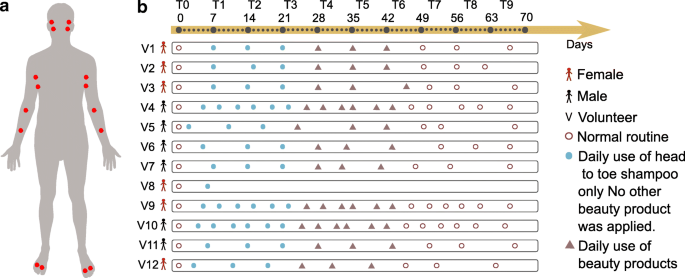
Study design and representation of changes in personal care regime over the course of 9 weeks. a Six males and six females were recruited and sampled using swabs on two locations from each body part (face, armpits, front forearms, and between toes) on the right and left side. The locations sampled were the face—upper cheek bone and lower jaw, armpit—upper and lower area, arm—front of elbow (antecubitis) and forearm (antebrachium), and feet—in between the first and second toe and third and fourth toe. Volunteers were asked to follow specific instructions for the use of skin care products. b Following the use of their personal skin care products (brown circles), all volunteers used only the same head to toe shampoo during the first 3 weeks (week 1–week 3) and no other beauty product was applied (solid blue circle). The following 3 weeks (week 4–week 6), four selected commercial beauty products were applied daily by all volunteers on the specific body part (deodorant antiperspirant for the armpits, soothing foot powder for the feet between toes, sunscreen for the face, and moisturizer for the front forearm) (triangles) and continued to use the same shampoo. During the last 3 weeks (week 7–week 9), all volunteers went back to their normal routine and used their personal beauty products (circles). Samples were collected once a week (from day 0 to day 68—10 timepoints from T0 to T9) for volunteers 1, 2, 3, 4, 5, 6, 7, 9, 10, 11, and 12, and on day 0 and day 6 for volunteer 8, who withdraw from the study after day 6. For 3 individuals (volunteers 4, 9, 10), samples were collected twice a week (19 timepoints total). Samples collected for 11 volunteers during 10 timepoints: 11 volunteers × 10 timepoints × 4 samples × 4 body sites = 1760. Samples collected from 3 selected volunteers during 9 additional timepoints: 3 volunteers × 9 timepoints × 4 samples × 4 body sites = 432. See also the “ Subject recruitment and sample collection ” section in the “ Methods ” section
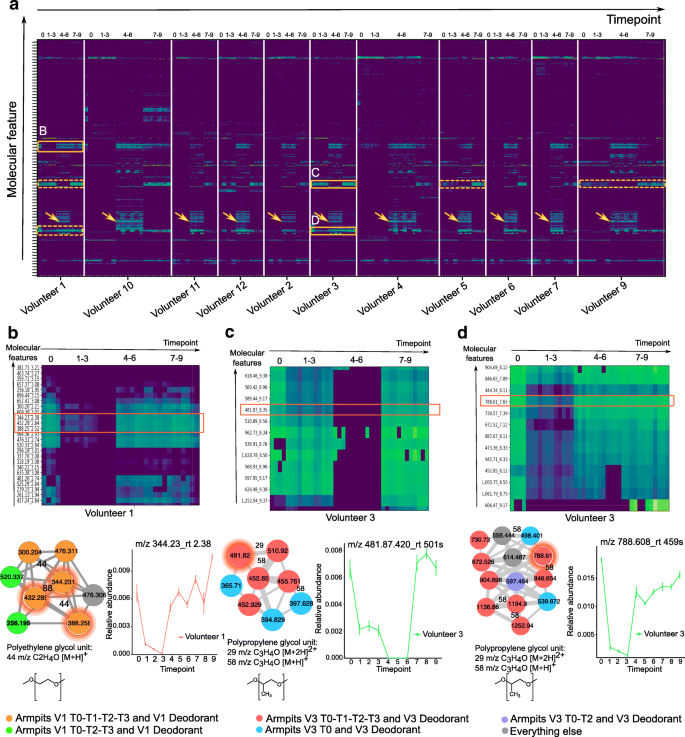
Monitoring the persistence of personal care product ingredients in the armpits over a 9-week period. a Heatmap representation of the most abundant molecular features detected in the armpits of all individuals during the four phases (0: initial, 1–3: no beauty products, 4–6: common products, and 7–9: personal products). Green color in the heatmap represents the highest molecular abundance and blue color the lowest one. Orange boxes with plain lines represent enlargement of cluster of molecules that persist on the armpits of volunteer 1 ( b ) and volunteer 3 ( c , d ). Orange clusters with dotted lines represent same clusters of molecules found on the armpits of other volunteers. Orange arrows represent the cluster of compounds characteristic of the antiperspirant used during T4–T6. b Polyethylene glycol (PEG) molecular clusters that persist on the armpits of individual 1. The molecular subnetwork, representing molecular families [ 24 ], is part of a molecular network ( http://gnps.ucsd.edu/ProteoSAFe/status.jsp?task=f5325c3b278a46b29e8860ec5791d5ad ) generated from MS/MS data collected from the armpits of volunteer 1 (T0–T3) MSV000081582 and MS/MS data collected from the deodorant used by volunteer 1 before the study started (T0) MSV000081580. c , d Polypropylene glycol (PPG) molecular families that persist on the armpits of individual 3, along with the corresponding molecular subnetwork that is part of the molecular network accessible here http://gnps.ucsd.edu/ProteoSAFe/status.jsp?task=aaa1af68099d4c1a87e9a09f398fe253 . Subnetworks were generated from MS/MS data collected from the armpits of volunteer 3 (T0–T3) MSV000081582 and MS/MS data collected from the deodorant used by volunteer 3 at T0 MSV000081580. The network nodes were annotated with colors. Nodes represent MS/MS spectra found in armpit samples of individual 1 collected during T0, T1, T2, and T3 and in personal deodorant used by individual 1 (orange nodes); armpit samples of individual 1 collected during T0, T2, and T3 and personal deodorant used by individual 1 (green nodes); armpit samples of individual 3 collected during T0, T1, T2, and T3 and in personal deodorant used by individual 3 (red nodes); armpit samples of individual 3 collected during T0 and in personal deodorant used by individual 3 (blue nodes); and armpit samples of individual 3 collected during T0 and T2 and in personal deodorant used by individual 3 (purple nodes). Gray nodes represent everything else. Error bars represent standard error of the mean calculated at each timepoint from four armpit samples collected from the right and left side of each individual separately. See also Additional file 1 : Figure S1
To understand how long beauty products persist on the skin, we monitored compounds found in deodorants used by two volunteers—female 1 and female 3—before the study (T0), over the first 3 weeks (T1–T3) (Fig. 1 b). During this phase, all participants used exclusively the same body wash during showering, making it easier to track ingredients of their personal care products. The data in the first 3 weeks (T1–T3) revealed that many ingredients of deodorants used on armpits (Fig. 2 a) persist on the skin during this time and were still detected during the first 3 weeks or at least during the first week following the last day of use. Each of the compounds detected in the armpits of individuals exhibited its own unique half-life. For example, the polyethylene glycol (PEG)-derived compounds m/z 344.227, rt 143 s (Fig. 2 b, S1J); m/z 432.279, rt 158 s (Fig. 2 b, S1K); and m/z 388.253, rt 151 s (Fig. 2 b, S1L) detected on armpits of volunteer 1 have a calculated half-life of 0.5 weeks (Additional file 1 : Figure S1J-L, all p values < 1.81e−07), while polypropylene glycol (PPG)-derived molecules m/z 481.87, rt 501 s (Fig. 2 c, S1M); m/z 560.420, rt 538 s (Fig. 2 c, S1N); m/z 788.608, rt 459 s (Fig. 2 d, S1O); m/z 846.650, rt 473 s (Fig. 2 d, S1P); and m/z 444.338, rt 486 s (Fig. 2 d, S1Q) found on armpits of volunteers 3 and 1 (Fig. 2 a) have a calculated half-life ranging from 0.7 to 1.9 weeks (Additional file 1 : Figure S1M-Q, all p values < 0.02), even though they originate from the same deodorant used by each individual. For some ingredients of deodorant used by volunteer 3 on time 0 (Additional file 1 : Figure S1M, N), a decline was observed during the first week, then little to no traces of these ingredients were detected during weeks 4–6 (T4–T6), then finally these ingredients reappear again during the last 3 weeks of personal product use (T7–T9). This suggests that these ingredients are present exclusively in the personal deodorant used by volunteer 3 before the study. Because a similar deodorant (Additional file 1 : Figure S1O-Q) and a face lotion (Additional file 1 : Figure S1R) was used by volunteer 3 and volunteer 2, respectively, prior to the study, there was no decline or absence of their ingredients during weeks 4–6 (T4–T6).
Polyethylene glycol compounds (Additional file 1 : Figure S1J-L) wash out faster from the skin than polypropylene glycol (Additional file 1 : Figure S1M-Q)(HL ~ 0.5 weeks vs ~ 1.9 weeks) and faster than fatty acids used in lotions (HL ~ 1.2 weeks) (Additional file 1 : Figure S1R), consistent with their hydrophilic (PEG) and hydrophobic properties (PPG and fatty acids) [ 25 , 26 ]. This difference in hydrophobicity is also reflected in the retention time as detected by mass spectrometry. Following the linear decrease of two PPG compounds from T0 to T1, they accumulated noticeably during weeks 2 and 3 (Additional file 1 : Figure S1M, N). This accumulation might be due to other sources of PPG such as the body wash used during this period or the clothes worn by person 3. Although PPG compounds were not listed in the ingredient list of the shampoo, we manually inspected the LC-MS data collected from this product and confirmed the absence of PPG compounds in the shampoo. The data suggest that this trend is characteristic of accumulation of PPG from additional sources. These could be clothes, beds, or sheets, in agreement with the observation of these molecules found in human habitats [ 27 ] but also in the public GNPS mass spectrometry dataset MSV000079274 that investigated the chemicals from dust collected from 1053 mattresses of children.
Temporal molecular and bacterial diversity in response to personal care use
To assess the effect of discontinuing and resuming the use of skin care products on molecular and microbiota dynamics, we first evaluated their temporal diversity. Skin sites varied markedly in their initial level (T0) of molecular and bacterial diversity, with higher molecular diversity at all sites for female participants compared to males (Fig. 3 a, b, Wilcoxon rank-sum-WR test, p values ranging from 0.01 to 0.0001, from foot to arm) and higher bacterial diversity in face (WR test, p = 0.0009) and armpits (WR test, p = 0.002) for females (Fig. 3 c, d). Temporal diversity was similar across the right and left sides of each body site of all individuals (WR test, molecular diversity: all p values > 0.05; bacterial diversity: all p values > 0.20). The data show that refraining from using beauty products (T1–T3) leads to a significant decrease in molecular diversity at all sites (Fig. 3 a, b, WR test, face: p = 8.29e−07, arm: p = 7.08e−09, armpit: p = 1.13e−05, foot: p = 0.002) and bacterial diversity mainly in armpits (WR test, p = 0.03) and feet (WR test, p = 0.04) (Fig. 3 c, d). While molecular diversity declined (Fig. 3 a, b) for arms and face, bacterial diversity (Fig. 3 c, d) was less affected in the face and arms when participants did not use skin care products (T1–T3). The molecular diversity remained stable in the arms and face of female participants during common beauty products use (T4–T6) to immediately increase as soon as the volunteers went back to their normal routines (T7–T9) (WR test, p = 0.006 for the arms and face)(Fig. 3 a, b). A higher molecular (Additional file 1 : Figure S2A) and community (Additional file 1 : Figure S2B) diversity was observed for armpits and feet of all individuals during the use of antiperspirant and foot powder (T4–T6) (WR test, molecular diversity: armpit p = 8.9e−33, foot p = 1.03e−11; bacterial diversity: armpit p = 2.14e−28, foot p = 1.26e−11), followed by a molecular and bacterial diversity decrease in the armpits when their regular personal beauty product use was resumed (T7–T9) (bacterial diversity: WR test, p = 4.780e−21, molecular diversity: WR test, p = 2.159e−21). Overall, our data show that refraining from using beauty products leads to lower molecular and bacterial diversity, while resuming the use increases their diversity. Distinct variations between male and female molecular and community richness were perceived at distinct body parts (Fig. 3 a–d). Although the chemical diversity of personal beauty products does not explain these variations (Additional file 1 : Figure S2C), differences observed between males and females may be attributed to many environmental and lifestyle factors including different original skin care and different frequency of use of beauty products (Additional file 2 : Table S1), washing routines, and diet.
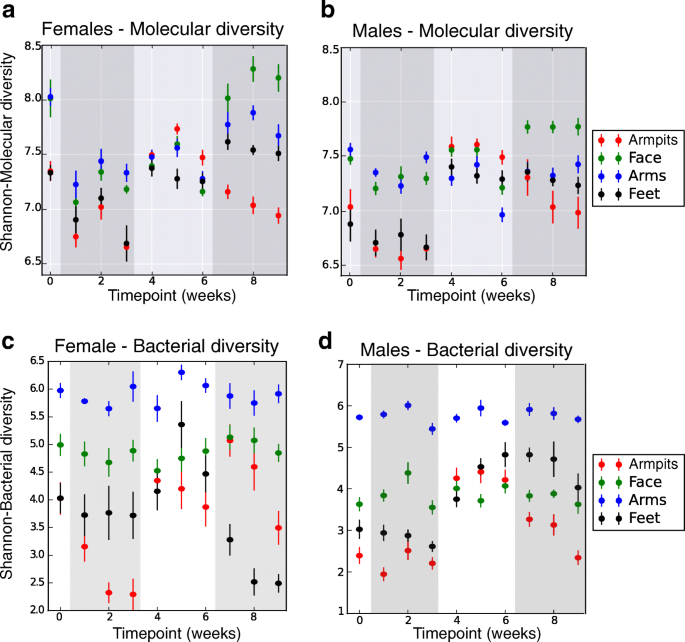
Molecular and bacterial diversity over a 9-week period, comparing samples based on their molecular (UPLC-Q-TOF-MS) or bacterial (16S rRNA amplicon) profiles. Molecular and bacterial diversity using the Shannon index was calculated from samples collected from each body part at each timepoint, separately for female ( n = 5) and male ( n = 6) individuals. Error bars represent standard error of the mean calculated at each timepoint, from up to four samples collected from the right and left side of each body part, of females ( n = 5) and males ( n = 6) separately. a , b Molecular alpha diversity measured using the Shannon index from five females (left panel) and six males (right panel), over 9 weeks, from four distinct body parts (armpits, face, arms, feet). c , d Bacterial alpha diversity measured using the Shannon index, from skin samples collected from five female (left panel) and six male individuals (right panel), over 9 weeks, from four distinct body parts (armpits, face, arms, feet). See also Additional file 1 : Figure S2
Longitudinal variation of skin metabolomics signatures
To gain insights into temporal metabolomics variation associated with beauty product use, chemical inventories collected over 9 weeks were subjected to multivariate analysis using the widely used Bray–Curtis dissimilarity metric (Fig. 4 a–c, S3A). Throughout the 9-week period, distinct molecular signatures were associated to each specific body site: arm, armpit, face, and foot (Additional file 1 : Figure S3A, Adonis test, p < 0.001, R 2 0.12391). Mass spectrometric signatures displayed distinct individual trends at each specific body site (arm, armpit, face, and foot) over time, supported by their distinct locations in PCoA (principal coordinate analysis) space (Fig. 4 a, b) and based on the Bray–Curtis distances between molecular profiles (Additional file 1 : Figure S3B, WR test, all p values < 0.0001 from T0 through T9). This suggests a high molecular inter-individual variability over time despite similar changes in personal care routines. Significant differences in molecular patterns associated to ceasing (T1–T3) (Fig. 4 b, Additional file 1 : Figure S3C, WR test, T0 vs T1–T3 p < 0.001) and resuming the use of common beauty products (T4–T6) (Additional file 1 : Figure S3C) were observed in the arm, face, and foot (Fig. 4 b), although the armpit exhibited the most pronounced changes (Fig. 4 b, Additional file 1 : Figure S3D, E, random forest highlighting that 100% of samples from each phase were correctly predicted). Therefore, we focused our analysis on this region. Molecular changes were noticeable starting the first week (T1) of discontinuing beauty product use. As shown for armpits in Fig. 4 c, these changes at the chemical level are specific to each individual, possibly due to the extremely personalized lifestyles before the study and match their original use of deodorant. Based on the initial use of underarm products (T0) (Additional file 2 : Table S1), two groups of participants can be distinguished: a group of five volunteers who used stick deodorant as evidenced by the mass spectrometry data and another group of volunteers where we found few or no traces suggesting they never or infrequently used stick deodorants (Additional file 2 : Table S1). Based on this criterion, the chemical trends shown in Fig. 4 c highlight that individuals who used stick deodorant before the beginning of the study (volunteers 1, 2, 3, 9, and 12) displayed a more pronounced shift in their armpits’ chemistries as soon as they stopped using deodorant (T1–T3), compared to individuals who had low detectable levels of stick deodorant use (volunteers 4, 6, 7, and 10), or “rarely-to-never” (volunteers 5 and 11) use stick deodorants as confirmed by the volunteers (Additional file 1 : Figure S3F, WR test, T0 vs T1–T3 all p values < 0.0001, with greater distance for the group of volunteers 1, 2, 3, 9, and 12, compared to volunteers 4, 5, 6, 7, 10, and 11). The most drastic shift in chemical profiles was observed during the transition period, when all participants applied the common antiperspirant on a daily basis (T4–T6) (Additional file 1 : Figure S3D, E). Finally, the molecular profiles became gradually more similar to those collected before the experiment (T0) as soon as the participants resumed using their personal beauty products (T7–T9) (Additional file 1 : Figure S3C), although traces of skin care products did last through the entire T7–T9 period in people who do not routinely apply these products (Fig. 4 c).
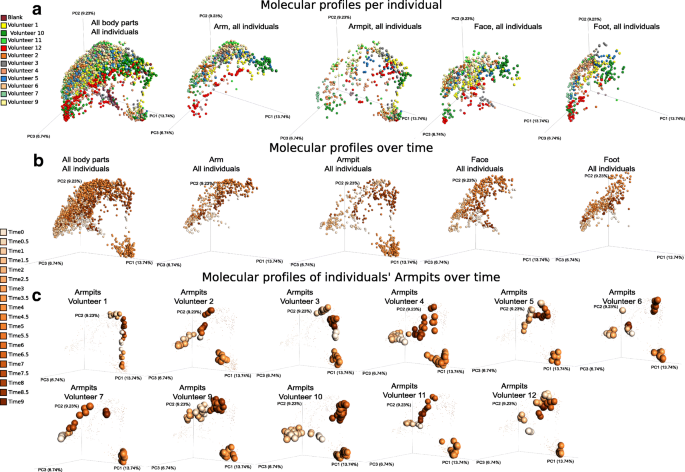
Individualized influence of beauty product application on skin metabolomics profiles over time. a Multivariate statistical analysis (principal coordinate analysis (PCoA)) comparing mass spectrometry data collected over 9 weeks from the skin of 11 individuals, all body parts, combined (first plot from the left) and then displayed separately (arm, armpits, face, feet). Color scale represents volunteer ID. The PCoA was calculated on all samples together, and subsets of the data are shown in this shared space and the other panels. b The molecular profiles collected over 9 weeks from all body parts, combined then separately (arm, armpits, face, feet). c Representative molecular profiles collected over 9 weeks from armpits of 11 individuals (volunteers 1, 2, 3, 4, 5, 6, 7, 9, 10, 11, 12). Color gradient in b and c represents timepoints (time 0 to time 9), ranging from the lightest orange color to the darkest one that represent the earliest (time 0) to the latest (time 9) timepoint, respectively. 0.5 timepoints represent additional timepoints where three selected volunteers were samples (volunteers 4, 9, and 10). PCoA plots were generated using the Bray–Curtis dissimilarity matrix and visualized in Emperor [ 28 ]. See also Additional file 1 : Figure S3
Comparing chemistries detected in armpits at the end timepoints—when no products were used (T3) and during product use (T6)—revealed distinct molecular signatures characteristic of each phase (random forest highlighting that 100% of samples from each group were correctly predicted, see Additional file 1 : Figure S3D, E). Because volunteers used the same antiperspirant during T4–T6, molecular profiles converged during that time despite individual patterns at T3 (Fig. 4 b, c, Additional file 1 : Figure S3D). These distinct chemical patterns reflect the significant impact of beauty products on skin molecular composition. Although these differences may in part be driven by beauty product ingredients detected on the skin (Additional file 1 : Figure S1), we anticipated that additional host- and microbe-derived molecules may also be involved in these molecular changes.
To characterize the chemistries that vary over time, we used molecular networking, a MS visualization approach that evaluates the relationship between MS/MS spectra and compares them to reference MS/MS spectral libraries of known compounds [ 29 , 30 ]. We recently showed that molecular networking can successfully organize large-scale mass spectrometry data collected from the human skin surface [ 18 , 19 ]. Briefly, molecular networking uses the MScluster algorithm [ 31 ] to merge all identical spectra and then compares and aligns all unique pairs of MS/MS spectra based on their similarities where 1.0 indicates a perfect match. Similarities between MS/MS spectra are calculated using a similarity score, and are interpreted as molecular families [ 19 , 24 , 32 , 33 , 34 ]. Here, we used this method to compare and characterize chemistries found in armpits, arms, face, and foot of 11 participants. Based on MS/MS spectral similarities, chemistries highlighted through molecular networking (Additional file 1 : Figure S4A) were associated with each body region with 8% of spectra found exclusively in the arms, 12% in the face, 14% in the armpits, and 2% in the foot, while 18% of the nodes were shared between all four body parts and the rest of spectra were shared between two body sites or more (Additional file 1 : Figure S4B). Greater spectral similarities were highlighted between armpits, face, and arm (12%) followed by the arm and face (9%) (Additional file 1 : Figure S4B).
Molecules were annotated with Global Natural Products Social Molecular Networking (GNPS) libraries [ 29 ], using accurate parent mass and MS/MS fragmentation patterns, according to level 2 or 3 of annotation defined by the 2007 metabolomics standards initiative [ 35 ]. Through annotations, molecular networking revealed that many compounds derived from steroids (Fig. 5 a–d), bile acids (Additional file 1 : Figure S5A-D), and acylcarnitines (Additional file 1 : Figure S5E-F) were exclusively detected in the armpits. Using authentic standards, the identity of some pheromones and bile acids were validated to a level 1 identification with matched retention times (Additional file 1 : Figure S6B, S7A, C, D). Other steroids and bile acids were either annotated using standards with identical MS/MS spectra but slightly different retention times (Additional file 1 : Figure S6A) or annotated with MS/MS spectra match with reference MS/MS library spectra (Additional file 1 : Figure S6C, D, S7B, S6E-G). These compounds were therefore classified as level 3 [ 35 ]. Acylcarnitines were annotated to a family of possible acylcarnitines (we therefore classify as level 3), as the positions of double bonds or cis vs trans configurations are unknown (Additional file 1 : Figure S8A, B).
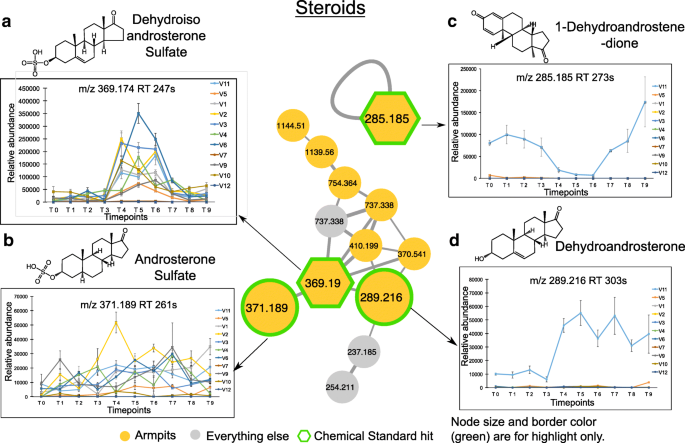
Underarm steroids and their longitudinal abundance. a – d Steroid molecular families in the armpits and their relative abundance over a 9-week period. Molecular networking was applied to characterize chemistries from the skin of 11 healthy individuals. The full network is shown in Additional file 1 : Figure S4A, and networking parameters can be found here http://gnps.ucsd.edu/ProteoSAFe/status.jsp?task=284fc383e4c44c4db48912f01905f9c5 for MS/MS datasets MSV000081582. Each node represents a consensus of a minimum of 3 identical MS/MS spectra. Yellow nodes represent MS/MS spectra detected in armpits samples. Hexagonal shape represents MS/MS spectra match between skin samples and chemical standards. Plots are representative of the relative abundance of each compound over time, calculated separately from LC-MS1 data collected from the armpits of each individual. Steroids detected in armpits are a , dehydroisoandrosterone sulfate ( m/z 369.190, rt 247 s), b androsterone sulfate ( m/z 371.189, rt 261 s), c 1-dehydroandrostenedione ( m/z 285.185, rt 273 s), and d dehydroandrosterone ( m/z 289.216, rt 303 s). Relative abundance over time of each steroid compound is represented. Error bars represent the standard error of the mean calculated at each timepoint from four armpit samples from the right and left side of each individual separately. See also Additional file 1 : Figures S4-S8
Among the steroid compounds, several molecular families were characterized: androsterone (Fig. 5 a, b, d), androstadienedione (Fig. 5 c), androstanedione (Additional file 1 : Figure S6E), androstanolone (Additional file 1 : Figure S6F), and androstenedione (Additional file 1 : Figure S6G). While some steroids were detected in the armpits of several individuals, such as dehydroisoandrosterone sulfate ( m/z 369.19, rt 247 s) (9 individuals) (Fig. 5 a, Additional file 1 : Figure S6A), androsterone sulfate ( m/z 371.189, rt 261 s) (9 individuals) (Fig. 5 b, Additional file 1 : Figure S6C), and 5-alpha-androstane-3,17-dione ( m/z 271.205, rt 249 s) (9 individuals) (Additional file 1 : Figure S6E), other steroids including 1-dehydroandrostenedione ( m/z 285.185, rt 273 s) (Fig. 5 c, Additional file 1 : Figure S6B), dehydroandrosterone ( m/z 289.216, rt 303 s) (Fig. 5 d, Additional file 1 : Figure S6D), and 5-alpha-androstan-17.beta-ol-3-one ( m/z 291.231, rt 318 s) (Additional file 1 : Figure S6F) were only found in the armpits of volunteer 11 and 4-androstene-3,17-dione ( m/z 287.200, rt 293 s) in the armpits of volunteer 11 and volunteer 5, both are male that never applied stick deodorants (Additional file 1 : Figure S6G). Each molecular species exhibited a unique pattern over the 9-week period. The abundance of dehydroisoandrosterone sulfate (Fig. 5 a, WR test, p < 0.01 for 7 individuals) and dehydroandrosterone (Fig. 5 a, WR test, p = 0.00025) significantly increased during the use of antiperspirant (T4–T6), while androsterone sulfate (Fig. 5 b) and 5-alpha-androstane-3,17-dione (Additional file 1 : Figure S6E) display little variation over time. Unlike dehydroisoandrosterone sulfate (Fig. 5 a) and dehydroandrosterone (Fig. 5 d), steroids including 1-dehydroandrostenedione (Fig. 5 c, WR test, p = 0.00024) and 4-androstene-3,17-dione (Additional file 1 : Figure S6G, WR test, p = 0.00012) decreased in abundance during the 3 weeks of antiperspirant application (T4–T6) in armpits of male 11, and their abundance increased again when resuming the use of his normal skin care routines (T7–T9). Interestingly, even within the same individual 11, steroids were differently impacted by antiperspirant use as seen for 1-dehydroandrostenedione that decreased in abundance during T4–T6 (Fig. 5 c, WR test, p = 0.00024), while dehydroandrosterone increased in abundance (Fig. 5 d, WR test, p = 0.00025), and this increase was maintained during the last 3 weeks of the study (T7–T9).
In addition to steroids, many bile acids (Additional file 1 : Figure S5A-D) and acylcarnitines (Additional file 1 : Figure S5E-F) were detected on the skin of several individuals through the 9-week period. Unlike taurocholic acid found only on the face (Additional file 1 : Figures S5A, S7A) and tauroursodeoxycholic acid detected in both armpits and arm samples (Additional file 1 : Figures S5B, S7B), other primary bile acids such as glycocholic (Additional file 1 : Figures S5C, S7C) and chenodeoxyglycocholic acid (Additional file 1 : Figures S5D, S7D) were exclusively detected in the armpits. Similarly, acylcarnitines were also found either exclusively in the armpits (hexadecanoyl carnitines) (Additional file 1 : Figures S5E, S8A) or in the armpits and face (tetradecenoyl carnitine) (Additional file 1 : Figures S5F, S8B) and, just like the bile acids, they were also stably detected during the whole 9-week period.
Bacterial communities and their variation over time
Having demonstrated the impact of beauty products on the chemical makeup of the skin, we next tested the extent to which skin microbes are affected by personal care products. We assessed temporal variation of bacterial communities detected on the skin of healthy individuals by evaluating dissimilarities of bacterial collections over time using unweighted UniFrac distance [ 36 ] and community variation at each body site in association to beauty product use [ 3 , 15 , 37 ]. Unweighted metrics are used for beta diversity calculations because we are primarily concerned with changes in community membership rather than relative abundance. The reason for this is that skin microbiomes can fluctuate dramatically in relative abundance on shorter timescales than that assessed here. Longitudinal variations were revealed for the armpits (Fig. 6 a) and feet microbiome by their overall trend in the PCoA plots (Fig. 6 b), while the arm (Fig. 6 c) and face (Fig. 6 d) displayed relatively stable bacterial profiles over time. As shown in Fig. 6 a–d, although the microbiome was site-specific, it varied more between individuals and this inter-individual variability was maintained over time despite same changes in personal care routine (WR test, all p values at all timepoints < 0.05, T5 p = 0.07), in agreement with previous findings that individual differences in the microbiome are large and stable over time [ 3 , 4 , 10 , 37 ]. However, we show that shifts in the microbiome can be induced by changing hygiene routine and therefore skin chemistry. Changes associated with using beauty products (T4–T6) were more pronounced for the armpits (Fig. 6 a, WR test, p = 1.61e−52) and feet (Fig. 6 b, WR test, p = 6.15e−09), while little variations were observed for the face (Fig. 6 d, WR test, p = 1.402.e−83) and none for the arms (Fig. 6 c, WR test, p = 0.296).

Longitudinal variation of skin bacterial communities in association with beauty product use. a - d Bacterial profiles collected from skin samples of 11 individuals, over 9 weeks, from four distinct body parts a) armpits, b) feet, c) arms and d) face, using multivariate statistical analysis (Principal Coordinates Analysis PCoA) and unweighted Unifrac metric. Each color represents bacterial samples collected from an individual. PCoA were calculated separately for each body part. e , f Representative Gram-negative (Gram -) bacteria collected from arms, armpits, face and feet of e) female and f) male participants. See also Additional file 1 : Figure S9A, B showing Gram-negative bacterial communities represented at the genus level
A significant increase in abundance of Gram-negative bacteria including the phyla Proteobacteria and Bacteroidetes was noticeable for the armpits and feet of both females (Fig. 6 e; Mann–Whitney U , p = 8.458e−07) and males (Fig. 6 f; Mann–Whitney U , p = 0.0004) during the use of antiperspirant (T4–T6), while their abundance remained stable for the arms and face during that time (Fig. 6 e, f; female arm p = 0.231; female face p value = 0.475; male arm p = 0.523;male face p = 6.848751e−07). These Gram-negative bacteria include Acinetobacter and Paracoccus genera that increased in abundance in both armpits and feet of females (Additional file 1 : Figure S9A), while a decrease in abundance of Enhydrobacter was observed in the armpits of males (Additional file 1 : Figure S9B). Cyanobacteria, potentially originating from plant material (Additional file 1 : Figure S9C) also increased during beauty product use (T4–T6) especially in males, in the armpits and face of females (Fig. 6 e) and males (Fig. 6 f). Interestingly, although chloroplast sequences (which group phylogenetically within the cyanobacteria [ 38 ]) were only found in the facial cream (Additional file 1 : Figure S9D), they were detected in other locations as well (Fig. 6 e, f. S9E, F), highlighting that the application of a product in one region will likely affect other regions of the body. For example, when showering, a face lotion will drip down along the body and may be detected on the feet. Indeed, not only did the plant material from the cream reveal this but also the shampoo used for the study for which molecular signatures were readily detected on the feet as well (Additional file 1 : Figure S10A). Minimal average changes were observed for Gram-positive organisms (Additional file 1 : Figure S10B, C), although in some individuals the variation was greater than others (Additional file 1 : Figure S10D, E) as discussed for specific Gram-positive taxa below.
At T0, the armpit’s microflora was dominated by Staphylococcus (26.24%, 25.11% of sequencing reads for females and 27.36% for males) and Corynebacterium genera (26.06%, 17.89% for females and 34.22% for males) (Fig. 7 a—first plot from left and Additional file 1 : Figure S10D, E). They are generally known as the dominant armpit microbiota and make up to 80% of the armpit microbiome [ 39 , 40 ]. When no deodorants were used (T1–T3), an overall increase in relative abundance of Staphylococcus (37.71%, 46.78% for females and 30.47% for males) and Corynebacterium (31.88%, 16.50% for females and 44.15% for males) genera was noticeable (WR test, p < 3.071e−05) (Fig. 7 a—first plot from left), while the genera Anaerococcus and Peptoniphilus decreased in relative abundance (WR test, p < 0.03644) (Fig. 7 a—first plot from left and Additional file 1 : Figure S10D, E). When volunteers started using antiperspirants (T4–T6), the relative abundance of Staphylococcus (37.71%, 46.78% females and 30.47% males, to 21.71%, 25.02% females and 19.25% males) and Corynebacterium (31.88%, 16.50% females and 44.15% males, to 15.83%, 10.76% females and 19.60% males) decreased (WR test, p < 3.071e−05) (Fig. 7 a, Additional file 1 : Figure S10D, E) and at the same time, the overall alpha diversity increased significantly (WR test, p = 3.47e−11) (Fig. 3 c, d). The microbiota Anaerococcus (WR test, p = 0.0006018) , Peptoniphilus (WR test, p = 0.008639), and Micrococcus (WR test, p = 0.0377) increased significantly in relative abundance, together with a lot of additional low-abundant species that lead to an increase in Shannon alpha diversity (Fig. 3 c, d). When participants went back to normal personal care products (T7–T9), the underarm microbiome resembled the original underarm community of T0 (WR test, p = 0.7274) (Fig. 7 a). Because armpit bacterial communities are person-specific (inter-individual variability: WR test, all p values at all timepoints < 0.05, besides T5 p n.s), variation in bacterial abundance upon antiperspirant use (T4–T6) differ between individuals and during the whole 9-week period (Fig. 7a —taxonomic plots per individual). For example, the underarm microbiome of male 5 exhibited a unique pattern, where Corynebacterium abundance decreased drastically during the use of antiperspirant (82.74 to 11.71%, WR test, p = 3.518e−05) while in the armpits of female 9 a huge decrease in Staphylococcus abundance was observed (Fig. 7 a) (65.19 to 14.85%, WR test, p = 0.000113). Unlike other participants, during T0–T3, the armpits of individual 11 were uniquely characterized by the dominance of a sequence that matched most closely to the Enhydrobacter genera . The transition to antiperspirant use (T4–T6) induces the absence of Enhydrobacter (30.77 to 0.48%, WR test, p = 0.01528) along with an increase of Corynebacterium abundance (26.87 to 49.74%, WR test, p = 0.1123) (Fig. 7 a—male 11).
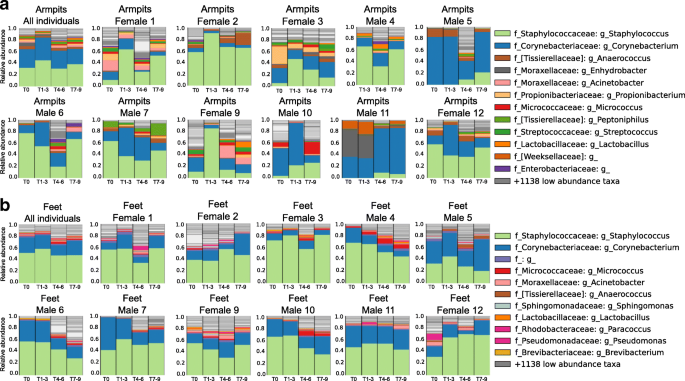
Person-to-person bacterial variabilities over time in the armpits and feet. a Armpit microbiome changes when stopping personal care product use, then resuming. Armpit bacterial composition of the 11 volunteers combined, then separately, (female 1, female 2, female 3, male 4, male 5, male 6, male 7, female 9, male 10, male 11, female 12) according to the four periods within the experiment. b Feet bacterial variation over time of the 12 volunteers combined, then separately (female 1, female 2, female 3, male 4, male 5, male 6, male 7, female 9, male 10, male 11, female 12) according to the four periods within the experiment. See also Additional file 1 : Figure S9-S13
In addition to the armpits, a decline in abundance of Staphylococcus and Corynebacterium was perceived during the use of the foot powder (46.93% and 17.36%, respectively) compared to when no beauty product was used (58.35% and 22.99%, respectively) (WR test, p = 9.653e−06 and p = 0.02032, respectively), while the abundance of low-abundant foot bacteria significantly increased such as Micrococcus (WR test, p = 1.552e−08), Anaerococcus (WR test, p = 3.522e−13), Streptococcus (WR test, p = 1.463e−06), Brevibacterium (WR test, p = 6.561e−05), Moraxellaceae (WR test, p = 0.0006719), and Acinetobacter (WR test, p = 0.001487), leading to a greater bacterial diversity compared to other phases of the study (Fig. 7 b first plot from left, Additional file 1 : Figure S10D, E, Fig. 3 c, d).
We further evaluated the relationship between the two omics datasets by superimposing the principal coordinates calculated from metabolome and microbiome data (Procrustes analysis) (Additional file 1 : Figure S11) [ 34 , 41 , 42 ]. Metabolomics data were more correlated with patterns observed in microbiome data in individual 3 (Additional file 1 : Figure S11C, Mantel test, r = 0.23, p < 0.001), individual 5 (Additional file 1 : Figure S11E, r = 0.42, p < 0.001), individual 9 (Additional file 1 : Figure S11H, r = 0.24, p < 0.001), individual 10 (Additional file 1 : Figure S11I, r = 0.38, p < 0.001), and individual 11 (Additional file 1 : Figure S11J, r = 0.35, p < 0.001) when compared to other individuals 1, 2, 4, 6, 7, and 12 (Additional file 1 : Figure S11A, B, D, F, G, K, respectively) (Mantel test, all r < 0.2, all p values < 0.002, for volunteer 2 p n.s). Furthermore, these correlations were individually affected by ceasing (T1–T3) or resuming the use of beauty products (T4–T6 and T7–T9) (Additional file 1 : Figure S11A-K).
Overall, metabolomics–microbiome correlations were consistent over time for the arms, face, and feet although alterations were observed in the arms of volunteers 7 (Additional file 1 : Figure S11G) and 10 (Additional file 1 : Figure S11I) and the face of volunteer 7 (Additional file 1 : Figure S11G) during product use (T4–T6). Molecular–bacterial correlations were mostly affected in the armpits during antiperspirant use (T4–T6), as seen for volunteers male 7 (Additional file 1 : Figure S11G) and 11 (Additional file 1 : Figure S11J) and females 2 (Additional file 1 : Figure S11B), 9 (Additional file 1 : Figure S11H), and 12 (Additional file 1 : Figure S11K). This perturbation either persisted during the last 3 weeks (Additional file 1 : Figure S11D, E, H, I, K) when individuals went back to their normal routine (T7–T9) or resembled the initial molecular–microbial correlation observed in T0 (Additional file 1 : Figure S11C, G, J). These alterations in molecular–bacterial correlation are driven by metabolomics changes during antiperspirant use as revealed by metabolomics shifts on the PCoA space (Additional file 1 : Figure S11), partially due to the deodorant’s chemicals (Additional file 1 : Figure S1J, K) but also to changes observed in steroid levels in the armpits (Fig. 5A, C, D , Additional file 1 : Figure S6G), suggesting metabolome-dependant changes of the skin microbiome. In agreement with previous findings that showed efficient biotransformation of steroids by Corynebacterium [ 43 , 44 ], our correlation analysis associates specific steroids that were affected by antiperspirant use in the armpits of volunteer 11 (Fig. 5 c, d, Additional file 1 : Figure S6G) with microbes that may produce or process them: 1-dehydroandrostenedione, androstenedione, and dehydrosterone with Corynebacterium ( r = − 0.674, p = 6e−05; r = 0.671, p = 7e−05; r = 0.834, p < 1e−05, respectively) (Additional file 1 : Figure S12A, B, C, respectively) and Enhydrobacter ( r = 0.683, p = 4e−05; r = 0.581, p = 0.00095; r = 0.755, p < 1e−05 respectively) (Additional file 1 : Figure S12D, E, F, respectively).
Despite the widespread use of skin care and hygiene products, their impact on the molecular and microbial composition of the skin is poorly studied. We established a workflow that examines individuals to systematically study the impact of such lifestyle characteristics on the skin by taking a broad look at temporal molecular and bacterial inventories and linking them to personal skin care product use. Our study reveals that when the hygiene routine is modified, the skin metabolome and microbiome can be altered, but that this alteration depends on product use and location on the body. We also show that like gut microbiome responses to dietary changes [ 20 , 21 ], the responses are individual-specific.
We recently reported that traces of our lifestyle molecules can be detected on the skin days and months after the original application [ 18 , 19 ]. Here, we show that many of the molecules associated with our personal skin and hygiene products had a half-life of 0.5 to 1.9 weeks even though the volunteers regularly showered, swam, or spent time in the ocean. Thus, a single application of some of these products has the potential to alter the microbiome and skin chemistry for extensive periods of time. Our data suggests that although host genetics and diet may play a role, a significant part of the resilience of the microbiome that has been reported [ 10 , 45 ] is due to the resilience of the skin chemistry associated with personal skin and hygiene routines, or perhaps even continuous re-exposure to chemicals from our personal care routines that are found on mattresses, furniture, and other personal objects [ 19 , 27 , 46 ] that are in constant contact. Consistent with this observation is that individuals in tribal regions and remote villages that are infrequently exposed to the types of products used in this study have very different skin microbial communities [ 47 , 48 ] and that the individuals in this study who rarely apply personal care products had a different starting metabolome. We observed that both the microbiome and skin chemistry of these individuals were most significantly affected by these products. This effect by the use of products at T4–T6 on the volunteers that infrequently used them lasted to the end phase of the study even though they went back to infrequent use of personal care products. What was notable and opposite to what the authors originally hypothesized is that the use of the foot powder and antiperspirant increased the diversity of microbes and that some of this diversity continued in the T7–T9 phase when people went back to their normal skin and hygiene routines. It is likely that this is due to the alteration in the nutrient availability such as fatty acids and moisture requirements, or alteration of microbes that control the colonization via secreted small molecules, including antibiotics made by microbes commonly found on the skin [ 49 , 50 ].
We detected specific molecules on the skin that originated from personal care products or from the host. One ingredient that lasts on the skin is propylene glycol, which is commonly used in deodorants and antiperspirants and added in relatively large amounts as a humectant to create a soft and sleek consistency [ 51 ]. As shown, daily use of personal care products is leading to high levels of exposure to these polymers. Such polymers cause contact dermatitis in a subset of the population [ 51 , 52 ]. Our data reveal a lasting accumulation of these compounds on the skin, suggesting that it may be possible to reduce their dose in deodorants or frequency of application and consequently decrease the degree of exposure to such compounds. Formulation design of personal care products may be influenced by performing detailed outcome studies. In addition, longer term impact studies are needed, perhaps in multiple year follow-up studies, to assess if the changes we observed are permanent or if they will recover to the original state.
Some of the host- and microbiome-modified molecules were also detected consistently, such as acylcarnitines, bile acids, and certain steroids. This means that a portion of the molecular composition of a person’s skin is not influenced by the beauty products applied to the skin, perhaps reflecting the level of exercise for acylcarnitines [ 53 , 54 ] or the liver (dominant location where they are made) or gallbladder (where they are stored) function for bile acids. The bile acid levels are not related to sex and do not change in amount during the course of this study. While bile acids are typically associated with the human gut microbiome [ 34 , 55 , 56 , 57 , 58 ], it is unclear what their role is on the skin and how they get there. One hypothesis is that they are present in the sweat that is excreted through the skin, as this is the case for several food-derived molecules such as caffeine or drugs and medications that have been previously reported on the human skin [ 19 ] or that microbes synthesize them de novo [ 55 ]. The only reports we could find on bile acids being associated with the skin describe cholestasis and pruritus diseases. Cholestasis and pruritus in hepatobiliary disease have symptoms of skin bile acid accumulation that are thought to be responsible for severe skin itching [ 59 , 60 ]. However, since bile acids were found in over 50% of the healthy volunteers, their detection on the skin is likely a common phenotype among the general population and not only reflective of disease, consistent with recent reports challenging these molecules as biomarkers of disease [ 59 ]. Other molecules that were detected consistently came from personal care products.
Aside from molecules that are person-specific and those that do not vary, there are others that can be modified via personal care routines. Most striking is how the personal care routines influenced changes in hormones and pheromones in a personalized manner. This suggests that there may be personalized recipes that make it possible to make someone more or less attractive to others via adjustments of hormonal and pheromonal levels through alterations in skin care.
Here, we describe the utilization of an approach that combines metabolomics and microbiome analysis to assess the effect of modifying personal care regime on skin chemistry and microbes. The key findings are as follows: (1) Compounds from beauty products last on the skin for weeks after their first use despite daily showering. (2) Beauty products alter molecular and bacterial diversity as well as the dynamic and structure of molecules and bacteria on the skin. (3) Molecular and bacterial temporal variability is product-, site-, and person-specific, and changes are observed starting the first week of beauty product use. This study provides a framework for future investigations to understand how lifestyle characteristics such as diet, outdoor activities, exercise, and medications shape the molecular and microbial composition of the skin. These factors have been studied far more in their impact on the gut microbiome and chemistry than in the skin. Revealing how such factors can affect skin microbes and their associated metabolites may be essential to define long-term skin health by restoring the appropriate microbes particularly in the context of skin aging [ 61 ] and skin diseases [ 49 ] as has shown to be necessary for amphibian health [ 62 , 63 ], or perhaps even create a precision skin care approach that utilizes the proper care ingredients based on the microbial and chemical signatures that could act as key players in host defense [ 49 , 64 , 65 ].
Subject recruitment and sample collection
Twelve individuals between 25 and 40 years old were recruited to participate in this study, six females and six males. Female volunteer 8 dropped out of the study as she developed a skin irritation during the T1–T3 phase. All volunteers signed a written informed consent in accordance with the sampling procedure approved by the UCSD Institutional Review Board (Approval Number 161730). Volunteers were required to follow specific instructions during 9 weeks. They were asked to bring in samples of their personal care products they used prior to T0 so they could be sampled as well. Following the initial timepoint time 0 and during the first 3 weeks (week 1–week 3), volunteers were asked not to use any beauty products (Fig. 1 b). During the next 3 weeks (week 4–week 6), four selected commercial beauty products provided to all volunteers were applied once a day at specific body part (deodorant for the armpits, soothing foot powder between the toes, sunscreen for the face, and moisturizer for front forearms) (Fig. 1 b, Additional file 3 : Table S2 Ingredient list of beauty products). During the first 6 weeks, volunteers were asked to shower with a head to toe shampoo. During the last 3 weeks (week 7–week 9), all volunteers went back to their normal routine and used the personal care products used before the beginning of the study (Fig. 1 b). Volunteers were asked not to shower the day before sampling. Samples were collected by the same three researchers to ensure consistency in sampling and the area sampled. Researchers examined every subject together and collected metabolomics and microbiome samples from each location together. Samples were collected once a week (from day 0 to day 68—10 timepoints total) for volunteers 1, 2, 3, 4, 5, 6, 7, 9, 10, 11, and 12, and on day 0 and day 6 for volunteer 8. For individuals 4, 9, and 10, samples were collected twice a week. Samples collected for 11 volunteers during 10 timepoints: 11 volunteers × 10 timepoints × 4 samples × 4 body sites = 1760. Samples collected from 3 selected volunteers during 9 additional timepoints: 3 volunteers × 9 timepoints × 4 samples × 4 body sites = 432. All samples were collected following the same protocol described in [ 18 ]. Briefly, samples were collected over an area of 2 × 2 cm, using pre-moistened swabs in 50:50 ethanol/water solution for metabolomics analysis or in Tris-EDTA buffer for 16S rRNA sequencing. Four samples were collected from each body part right and left side. The locations sampled were the face—upper cheek bone and lower jaw, armpit—upper and lower area, arm—front of the elbow (antecubitis) and forearm (antebrachium), and feet—in between the first and second toe and third and fourth toe. Including personal care product references, a total of 2275 samples were collected over 9 weeks and were submitted to both metabolomics and microbial inventories.
Metabolite extraction and UPLC-Q-TOF mass spectrometry analysis
Skin swabs were extracted and analyzed using a previously validated workflow described in [ 18 , 19 ]. All samples were extracted in 200 μl of 50:50 ethanol/water solution for 2 h on ice then overnight at − 20 °C. Swab sample extractions were dried down in a centrifugal evaporator then resuspended by vortexing and sonication in a 100 μl 50:50 ethanol/water solution containing two internal standards (fluconazole 1 μM and amitriptyline 1 μM). The ethanol/water extracts were then analyzed using a previously validated UPLC-MS/MS method [ 18 , 19 ]. We used a ThermoScientific UltiMate 3000 UPLC system for liquid chromatography and a Maxis Q-TOF (Quadrupole-Time-of-Flight) mass spectrometer (Bruker Daltonics), controlled by the Otof Control and Hystar software packages (Bruker Daltonics) and equipped with ESI source. UPLC conditions of analysis are 1.7 μm C18 (50 × 2.1 mm) UHPLC Column (Phenomenex), column temperature 40 °C, flow rate 0.5 ml/min, mobile phase A 98% water/2% acetonitrile/0.1% formic acid ( v / v ), mobile phase B 98% acetonitrile/2% water/0.1% formic acid ( v / v ). A linear gradient was used for the chromatographic separation: 0–2 min 0–20% B, 2–8 min 20–99% B, 8–9 min 99–99% B, 9–10 min 0% B. Full-scan MS spectra ( m/z 80–2000) were acquired in a data-dependant positive ion mode. Instrument parameters were set as follows: nebulizer gas (nitrogen) pressure 2 Bar, capillary voltage 4500 V, ion source temperature 180 °C, dry gas flow 9 l/min, and spectra rate acquisition 10 spectra/s. MS/MS fragmentation of 10 most intense selected ions per spectrum was performed using ramped collision induced dissociation energy, ranged from 10 to 50 eV to get diverse fragmentation patterns. MS/MS active exclusion was set after 4 spectra and released after 30 s.
Mass spectrometry data collected from the skin of 12 individuals can be found here MSV000081582.
LC-MS data processing
LC-MS raw data files were converted to mzXML format using Compass Data analysis software (Bruker Daltonics). MS1 features were selected for all LC-MS datasets collected from the skin of 12 individuals and blank samples (total 2275) using the open-source software MZmine [ 66 ]—see Additional file 4 : Table S3 for parameters. Subsequent blank filtering, total ion current, and internal standard normalization were performed (Additional file 5 : Table S4) for representation of relative abundance of molecular features (Fig. 2 , Additional file 1 : Figure S1), principal coordinate analysis (PCoA) (Fig. 4 ). For steroid compounds in Fig. 5 a–d, bile acids (Additional file 1 : Figure S5A-D), and acylcarnitines (Additional file 1 : Figure S5E, F) compounds, crop filtering feature available in MZmine [ 66 ] was used to identify each feature separately in all LC-MS data collected from the skin of 12 individuals (see Additional file 4 : Table S3 for crop filtering parameters and feature finding in Additional file 6 : Table S5).
Heatmap in Fig. 2 was constructed from the bucket table generated from LC-MS1 features (Additional file 7 : Table S6) and associated metadata (Additional file 8 : Table S7) using the Calour command line available here: https://github.com/biocore/calour . Calour parameters were as follows: normalized read per sample 5000 and cluster feature minimum reads 50. Procrustes and Pearson correlation analyses in Additional file 1 : Figures S10 and S11 were performed using the feature table in Additional file 9 : Table S8, normalized using the probabilistic quotient normalization method [ 67 ].
16S rRNA amplicon sequencing
16S rRNA sequencing was performed following the Earth Microbiome Project protocols [ 68 , 69 ], as described before [ 18 ]. Briefly, DNA was extracted using MoBio PowerMag Soil DNA Isolation Kit and the V4 region of the 16S rRNA gene was amplified using barcoded primers [ 70 ]. PCR was performed in triplicate for each sample, and V4 paired-end sequencing [ 70 ] was performed using Illumina HiSeq (La Jolla, CA). Raw sequence reads were demultiplexed and quality controlled using the defaults, as provided by QIIME 1.9.1 [ 71 ]. The primary OTU table was generated using Qiita ( https://qiita.ucsd.edu/ ), using UCLUST ( https://academic.oup.com/bioinformatics/article/26/19/2460/230188 ) closed-reference OTU picking method against GreenGenes 13.5 database [ 72 ]. Sequences can be found in EBI under accession number EBI: ERP104625 or in Qiita ( qiita.ucsd.edu ) under Study ID 10370. Resulting OTU tables were then rarefied to 10,000 sequences/sample for downstream analyses (Additional file 10 Table S9). See Additional file 11 : Table S10 for read count per sample and Additional file 1 : Figure S13 representing the samples that fall out with rarefaction at 10,000 threshold. The dataset includes 35 blank swab controls and 699 empty controls. The blank samples can be accessed through Qiita ( qiita.ucsd.edu ) as study ID 10370 and in EBI with accession number EBI: ERP104625. Blank samples can be found under the metadata category “sample_type” with the name “empty control” and “Swabblank.” These samples fell below the rarefaction threshold at 10,000 (Additional file 11 : Table S10).
To rule out the possibility that personal care products themselves contained the microbes that induced the changes in the armpit and foot microbiomes that were observed in this study (Fig. 7 ), we subjected the common personal care products that were used in this study during T4–T6 also to 16S rRNA sequencing. The data revealed that within the limit of detectability of the current experiment, few 16S signatures were detected. One notable exception was the most dominant plant-originated bacteria chloroplast detected in the sunscreen lotion applied on the face (Additional file 1 : Figure S9D), that was also detected on the face of individuals and at a lower level on their arms, sites where stable microbial communities were observed over time (Additional file 1 : Figure S9E, F). This finding is in agreement with our previous data from the 3D cartographical skin maps that revealed the presence of co-localized chloroplast and lotion molecules [ 18 ]. Other low-abundant microbial signatures found in the sunscreen lotion include additional plant-associated bacteria: mitochondria [ 73 ], Bacillaceae [ 74 , 75 ], Planococcaceae [ 76 ], and Ruminococcaceae family [ 77 ], but all these bacteria are not responsible for microbial changes associated to beauty product use, as they were poorly detected in the armpits and feet (Fig. 7 ).
To assess the origin of Cyanobacteria detected in skin samples, each Greengenes [ 72 ] 13_8 97% OTU table (per lane; obtained from Qiita [ 78 ] study 10,370) was filtered to only features with a p__Cyanobacteria phylum. The OTU maps for these tables—which relate each raw sequence to an OTU ID—were then filtered to only those observed p__Cyanobacteria OTU IDs. The filtered OTU map was used to extract the raw sequences into a single file. Separately, the unaligned Greengenes 13_8 99% representative sequences were filtered into two sets, first the set of representatives associated with c__Chloroplast (our interest database), and second the set of sequences associated with p__Cyanobacteria without the c__Chloroplast sequences (our background database). Platypus Conquistador [ 79 ] was then used to determine what reads were observed exclusively in the interest database and not in the background database. Of the 4,926,465 raw sequences associated with a p__Cyanobacteria classification (out of 318,686,615 total sequences), at the 95% sequence identity level with 100% alignment, 4,860,258 sequences exclusively recruit to full-length chloroplast 16S by BLAST [ 80 ] with the bulk recruiting to streptophytes (with Chlorophyta and Stramenopiles to a lesser extent). These sequences do not recruit non-chloroplast Cyanobacteria full length 16S.
Half-life calculation for metabolomics data
In order to estimate the biological half-life of molecules detected in the skin, the first four timepoints of the study (T0, T1, T2, T3) were considered for the calculation to allow the monitoring of personal beauty products used at T0. The IUPAC’s definition of biological half-life as the time required to a substance in a biological system to be reduced to half of its value, assuming an approximately exponential removal [ 81 ] was used. The exponential removal can be described as C ( t ) = C 0 e − tλ where t represents the time in weeks, C 0 represents the initial concentration of the molecule, C ( t ) represents the concentration of the molecule at time t , and λ is the rate of removal [ http://onlinelibrary.wiley.com/doi/10.1002/9780470140451.ch2/summary ]. The parameter λ was estimated by a mixed linear effects model in order to account for the paired sample structure. The regression model tests the null hypothesis that λ is equal to zero and only the significant ( p value < 0.05) parameters were considered.
Principal coordinate analysis
We performed principal coordinate analysis (PCoA) on both metabolomics and microbiome data. For metabolomics, we used MS1 features (Additional file 5 : Table S4) and calculated Bray–Curtis dissimilarity metric using ClusterApp ( https://github.com/mwang87/q2_metabolomics ).
For microbiome data, we used rarefied OTU table (Additional file 10 : Table S9) and used unweighted UniFrac metric [ 36 ] to calculate beta diversity distance matrix using QIIME2 (https://qiime2.org). Results from both data sources were visualized using Emperor ( https://biocore.github.io/emperor/ ) [ 28 ].
Molecular networking
Molecular networking was generated from LC-MS/MS data collected from skin samples of 11 individuals MSV000081582, using the Global Natural Products Social Molecular Networking platform (GNPS) [ 29 ]. Molecular network parameters for MS/MS data collected from all body parts of 11 individuals during T0–T9 MSV000081582 are accessible here http://gnps.ucsd.edu/ProteoSAFe/status.jsp?task=284fc383e4c44c4db48912f01905f9c5 . Molecular network parameters for MS/MS data collected from armpits T0–T3 MSV000081582 and deodorant used by individual 1 and 3 MSV000081580 can be found here http://gnps.ucsd.edu/ProteoSAFe/status.jsp?task=f5325c3b278a46b29e8860ec57915ad and here http://gnps.ucsd.edu/ProteoSAFe/status.jsp?task=aaa1af68099d4c1a87e9a09f398fe253 , respectively. Molecular networks were exported and visualized in Cytoscape 3.4.0. [ 82 ]. Molecular networking parameters were set as follows: parent mass tolerance 1 Da, MS/MS fragment ion tolerance 0.5 Da, and cosine threshold 0.65 or greater, and only MS/MS spectral pairs with at least 4 matched fragment ions were included. Each MS/MS spectrum was only allowed to connect to its top 10 scoring matches, resulting in a maximum of 10 connections per node. The maximum size of connected components allowed in the network was 600, and the minimum number of spectra required in a cluster was 3. Venn diagrams were generated from Cytoscape data http://gnps.ucsd.edu/ProteoSAFe/status.jsp?task=284fc383e4c44c4db48912f01905f9c5 using Cytoscape [ 82 ] Venn diagram app available here http://apps.cytoscape.org/apps/all .
Shannon molecular and bacterial diversity
The diversity analysis was performed separately for 16S rRNA data and LC-MS data. For each sample in each feature table (LC-MS data and microbiome data), we calculated the value of the Shannon diversity index. For LC-MS data, we used the full MZmine feature table (Additional file 5 : Table S4). For microbiome data, we used the closed-reference BIOM table rarefied to 10,000 sequences/sample. For diversity changes between timepoints, we aggregated Shannon diversity values across groups of individuals (all, females, males) and calculated mean values and standard errors. All successfully processed samples (detected features in LC-MS or successful sequencing with 10,000 or more sequences/sample) were considered.
Beauty products and chemical standards
Samples (10 mg) from personal care products used during T0 and T7–T9 MSV000081580 (Additional file 2 : Table S1) and common beauty products used during T4–T6 MSV000081581 (Additional file 3 : Table S2) were extracted in 1 ml 50:50 ethanol/water. Sample extractions were subjected to the same UPLC-Q-TOF MS method used to analyze skin samples and described above in the section “ Metabolite extraction and UPLC-Q-TOF mass spectrometry analysis .” Authentic chemical standards MSV000081583 including 1-dehydroandrostenedion (5 μM), chenodeoxyglycocholic acid (5 μM), dehydroisoandrosterone sulfate (100 μM), glycocholic acid (5 μM), and taurocholic acid (5 μM) were analyzed using the same mass spectrometry workflow used to run skin and beauty product samples.
Monitoring beauty product ingredients in skin samples
In order to monitor beauty product ingredients used during T4–T6, we selected only molecular features present in each beauty product sample (antiperspirant, facial lotion, body moisturizer, soothing powder) and then filtered the aligned MZmine feature table (Additional file 5 : Table S4) for the specific feature in specific body part samples. After feature filtering, we selected all features that had a higher average intensity on beauty product phase (T4–T6) compared to non-beauty product phase (T1–T3). The selected features were annotated using GNPS dereplication output http://gnps.ucsd.edu/ProteoSAFe/status.jsp?task=69319caf219642a5a6748a3aba8914df , plotted using R package ggplot2 ( https://cran.r-project.org/web/packages/ggplot2/index.html ) and visually inspected for meaningful patterns.
Random forest analysis
Random forest analysis was performed in MetaboAnalyst 3.0 online platform http://www.metaboanalyst.ca/faces/home.xhtml . Using LC-MS1 features found in armpit samples collected on T3 and T6. Random forest parameters were set as follows: top 1000 most abundant features, number of predictors to try for each node 7, estimate of error rate (0.0%).
BugBase analysis
To determine the functional potential of microbial communities within our samples, we used BugBase [ 83 ]. Because we do not have direct access to all of the gene information due to the use of 16S rRNA marker gene sequencing, we can only rely on phylogenetic information inferred from OTUs. BugBase takes advantage of this information to predict microbial phenotypes by associating OTUs with gene content using PICRUSt [ 84 ]. Thus, using BugBase, we can predict such phenotypes as Gram staining, or oxidative stress tolerance at each timepoint or each phase. All statistical analyses in BugBase are performed using non-parametric differentiation tests (Mann–Whitney U ).
Taxonomic plots
Rarefied OTU counts were collapsed according to the OTU’s assigned family and genus name per sample, with a single exception for the class of chloroplasts. Relative abundances of each family-genus group are obtained by dividing by overall reads per sample, i.e., 10,000. Samples are grouped by volunteer, body site, and time/phase. Abundances are aggregated by taking the mean overall samples, and resulting abundances are again normalized to add up to 1. Low-abundant taxa are not listed in the legend and plotted in grayscale. Open-source code is available at https://github.com/sjanssen2/ggmap/blob/master/ggmap/snippets.py
Dissimilarity-based analysis
Pairwise dissimilarity matrices were generated for metabolomics and 16S metagenomics quantification tables, described above, using Bray–Curtis dissimilarity through QIIME 1.9.1 [ 71 ]. Those distance matrices were used to perform Procrustes analysis (QIIME 1.9.1), and Mantel test (scikit-bio version 0.5.1) to measure the correlation between the metabolome and microbiome over time. The metabolomics dissimilarities were used to perform the PERMANOVA test to assess the significance of body part grouping. The PCoA and Procrustes plots were visualized in EMPeror. The dissimilarity matrices were also used to perform distance tests, comparing the distances within and between individuals and distances from time 0 to times 1, 2, and 3 using Wilcoxon rank-sum tests (SciPy version 0.19.1) [ 19 ].
Statistical analysis for molecular and microbial data
Statistical analyses were performed in R and Python (R Core Team 2018). Monotonic relationships between two variables were tested using non-parametric Spearman correlation tests. The p values for correlation significance were subsequently corrected using Benjamini and Hochberg false discovery rate control method. The relationship between two groups was tested using non-parametric Wilcoxon rank-sum tests. The relationship between multiple groups was tested using non-parametric Kruskal–Wallis test. The significance level was set to 5%, unless otherwise mentioned, and all tests were performed as two-sided tests.
Oh J, Byrd AL, Deming C, Conlan S, Kong HH, Segre JA. Biogeography and individuality shape function in the human skin metagenome. Nature. 2014;514(7520):59–64.
Article CAS PubMed PubMed Central Google Scholar
Grice EA, Segre JA. The skin microbiome. Nat Rev Microbiol. 2011;9(4):244–53.
Costello EK, Lauber CL, Hamady M, Fierer N, Gordon JI, Knight R. Bacterial community variation in human body habitats across space and time. Science. 2009;326(5960):1694–7.
Grice EA, Kong HH, Conlan S, Deming CB, Davis J, Young AC, et al. Topographical and temporal diversity of the human skin microbiome. Science. 2009;324(5931):1190–2.
Urban J, Fergus DJ, Savage AM, Ehlers M, Menninger HL, Dunn RR, et al. The effect of habitual and experimental antiperspirant and deodorant product use on the armpit microbiome. PeerJ. 2016;4:e1605.
Article PubMed PubMed Central Google Scholar
Callewaert C, Hutapea P, Van de Wiele T, Boon N. Deodorants and antiperspirants affect the axillary bacterial community. Arch Dermatol Res. 2014;306(8):701–10.
Article CAS PubMed Google Scholar
Staudinger T, Pipal A, Redl B. Molecular analysis of the prevalent microbiota of human male and female forehead skin compared to forearm skin and the influence of make-up. J Appl Microbiol. 2011;110(6):1381–9.
Houben E, De Paepe K, Rogiers V. A keratinocyte’s course of life. Skin Pharmacol Physiol. 2007;20(3):122–32.
Hoath SB, Leahy DG. The organization of human epidermis: functional epidermal units and phi proportionality. J Invest Dermatol. 2003;121(6):1440–6.
Oh J, Byrd AL, Park M, Kong HH, Segre JA. Temporal stability of the human skin microbiome. Cell. 2016;165(4):854–66.
Schloissnig S, Arumugam M, Sunagawa S, Mitreva M, Tap J, Zhu A, et al. Genomic variation landscape of the human gut microbiome. Nature. 2013;493(7430):45–50.
Article PubMed Google Scholar
Faith JJ, Guruge JL, Charbonneau M, Subramanian S, Seedorf H, Goodman AL, et al. The long-term stability of the human gut microbiota. Science. 2013;341(6141):1237439.
Hall MW, Singh N, Ng KF, Lam DK, Goldberg MB, Tenenbaum HC, et al. Inter-personal diversity and temporal dynamics of dental, tongue, and salivary microbiota in the healthy oral cavity. NPJ Biofilms Microbiomes. 2017;3:2.
Utter DR, Mark Welch JL, Borisy GG. Individuality, stability, and variability of the plaque microbiome. Front Microbiol. 2016;7:564.
Flores GE, Caporaso JG, Henley JB, Rideout JR, Domogala D, Chase J, et al. Temporal variability is a personalized feature of the human microbiome. Genome Biol. 2014;15(12):531.
The Human Microbiome Project C. Structure, function and diversity of the healthy human microbiome. Nature [Article]. 2012;486:207.
Article Google Scholar
Dorrestein PC, Gallo RL, Knight R. Microbial skin inhabitants: friends forever. Cell. 2016;165(4):771–2.
Bouslimani A, Porto C, Rath CM, Wang M, Guo Y, Gonzalez A, et al. Molecular cartography of the human skin surface in 3D. Proc Natl Acad Sci U S A. 2015;112(17):E2120–9.
Bouslimani A, Melnik AV, Xu Z, Amir A, da Silva RR, Wang M, et al. Lifestyle chemistries from phones for individual profiling. Proc Natl Acad Sci U S A. 2016;113(48):E7645–E54.
David LA, Maurice CF, Carmody RN, Gootenberg DB, Button JE, Wolfe BE, et al. Diet rapidly and reproducibly alters the human gut microbiome. Nature. 2014;505(7484):559–63.
Wu GD, Chen J, Hoffmann C, Bittinger K, Chen YY, Keilbaugh SA, et al. Linking long-term dietary patterns with gut microbial enterotypes. Science. 2011;334(6052):105–8.
Unno M, Cho O, Sugita T. Inhibition of Propionibacterium acnes lipase activity by the antifungal agent ketoconazole. Microbiol Immunol. 2017;61(1):42–4.
Holland C, Mak TN, Zimny-Arndt U, Schmid M, Meyer TF, Jungblut PR, et al. Proteomic identification of secreted proteins of Propionibacterium acnes. BMC Microbiol. 2010;10:230.
Nguyen DD, Wu CH, Moree WJ, Lamsa A, Medema MH, Zhao X, et al. MS/MS networking guided analysis of molecule and gene cluster families. Proc Natl Acad Sci U S A. 2013;110(28):E2611–20.
Soltanpour S, Jouyban A. Solubility of acetaminophen and ibuprofen in polyethylene glycol 600, propylene glycol and water mixtures at 25°C. J Mol Liq. 2010;155(2):80–4.
Article CAS Google Scholar
Haglund BO. Solubility studies of polyethylene glycols in ethanol and water. Thermochimica Acta. 1987;114(1):97–102.
Petras D, Nothias LF, Quinn RA, Alexandrov T, Bandeira N, Bouslimani A, et al. Mass spectrometry-based visualization of molecules associated with human habitats. Anal Chem. 2016;88(22):10775–84.
Vazquez-Baeza Y, Pirrung M, Gonzalez A, Knight R. EMPeror: a tool for visualizing high-throughput microbial community data. Gigascience. 2013;2(1):16.
Wang M, Carver JJ, Phelan VV, Sanchez LM, Garg N, Peng Y, et al. Sharing and community curation of mass spectrometry data with Global Natural Products Social Molecular Networking. Nat Biotechnol. 2016;34(8):828–37.
Watrous J, Roach P, Alexandrov T, Heath BS, Yang JY, Kersten RD, et al. Mass spectral molecular networking of living microbial colonies. Proc Natl Acad Sci U S A. 2012;109(26):E1743–52.
Frank AM, Monroe ME, Shah AR, Carver JJ, Bandeira N, Moore RJ, et al. Spectral archives: extending spectral libraries to analyze both identified and unidentified spectra. Nat Methods. 2011;8(7):587–91.
Quinn RA, Nothias LF, Vining O, Meehan M, Esquenazi E, Dorrestein PC. Molecular networking as a drug discovery, drug metabolism, and precision medicine strategy. Trends Pharmacol Sci. 2017;38(2):143–54.
Luzzatto-Knaan T, Garg N, Wang M, Glukhov E, Peng Y, Ackermann G, et al. Digitizing mass spectrometry data to explore the chemical diversity and distribution of marine cyanobacteria and algae. Elife. 2017;6:e24214.
Melnik AV, da Silva RR, Hyde ER, Aksenov AA, Vargas F, Bouslimani A, et al. Coupling targeted and untargeted mass spectrometry for metabolome-microbiome-wide association studies of human fecal samples. Anal Chem. 2017;89(14):7549–59.
Sumner LW, Amberg A, Barrett D, Beale MH, Beger R, Daykin CA, et al. Proposed minimum reporting standards for chemical analysis Chemical Analysis Working Group (CAWG) Metabolomics Standards Initiative (MSI). Metabolomics. 2007;3(3):211–21.
Lozupone C, Knight R. UniFrac: a new phylogenetic method for comparing microbial communities. Appl Environ Microbiol. 2005;71(12):8228–35.
Caporaso JG, Lauber CL, Costello EK, Berg-Lyons D, Gonzalez A, Stombaugh J, et al. Moving pictures of the human microbiome. Genome Biol. 2011;12(5):R50.
Green BR. Chloroplast genomes of photosynthetic eukaryotes. Plant J. 2011;66(1):34–44.
Callewaert C, Kerckhof FM, Granitsiotis MS, Van Gele M, Van de Wiele T, Boon N. Characterization of Staphylococcus and Corynebacterium clusters in the human axillary region. PLoS One. 2013;8(8):e70538.
Callewaert C, Lambert J, Van de Wiele T. Towards a bacterial treatment for armpit malodour. Exp Dermatol. 2017;26(5):388–91.
Tripathi A, Melnik AV, Xue J, Poulsen O, Meehan MJ, Humphrey G, et al. Intermittent hypoxia and hypercapnia, a hallmark of obstructive sleep apnea, alters the gut microbiome and metabolome. mSystems. 2018;3(3):e00020-18.
Gower JC. Generalized procrustes analysis. Psychometrika [journal article]. 1975;40(1):33–51.
Decreau RA, Marson CM, Smith KE, Behan JM. Production of malodorous steroids from androsta-5,16-dienes and androsta-4,16-dienes by Corynebacteria and other human axillary bacteria. J Steroid Biochem Mol Biol. 2003;87(4–5):327–36.
Austin C, Ellis J. Microbial pathways leading to steroidal malodour in the axilla. J Steroid Biochem Mol Biol. 2003;87(1):105–10.
Lloyd-Price J, Mahurkar A, Rahnavard G, Crabtree J, Orvis J, Hall AB, et al. Strains, functions and dynamics in the expanded Human Microbiome Project. Nature. 2017;550(7674):61-6.
Kapono CA, Morton JT, Bouslimani A, Melnik AV, Orlinsky K, Knaan TL, et al. Creating a 3D microbial and chemical snapshot of a human habitat. Sci Rep. 2018;8(1):3669.
Clemente JC, Pehrsson EC, Blaser MJ, Sandhu K, Gao Z, Wang B, et al. The microbiome of uncontacted Amerindians. Sci Adv. 2015;1(3):e1500183.
Blaser MJ, Dominguez-Bello MG, Contreras M, Magris M, Hidalgo G, Estrada I, et al. Distinct cutaneous bacterial assemblages in a sampling of South American Amerindians and US residents. ISME J. 2013;7(1):85–95.
Nakatsuji T, Chen TH, Narala S, Chun KA, Two AM, Yun T, et al. Antimicrobials from human skin commensal bacteria protect against Staphylococcus aureus and are deficient in atopic dermatitis. Sci Transl Med 2017;9(378)eaah4680.
Hollands A, Gonzalez D, Leire E, Donald C, Gallo RL, Sanderson-Smith M, et al. A bacterial pathogen co-opts host plasmin to resist killing by cathelicidin antimicrobial peptides. J Biol Chem. 2012;287(49):40891–7.
Zirwas MJ, Moennich J. Antiperspirant and deodorant allergy: diagnosis and management. J Clin Aesthet Dermatol. 2008;1(3):38–43.
PubMed PubMed Central Google Scholar
Funk JO, Maibach HI. Propylene glycol dermatitis: re-evaluation of an old problem. Contact Dermatitis. 1994;31(4):236–41.
Lehmann R, Zhao X, Weigert C, Simon P, Fehrenbach E, Fritsche J, et al. Medium chain acylcarnitines dominate the metabolite pattern in humans under moderate intensity exercise and support lipid oxidation. PLoS One. 2010;5(7):e11519.
Hiatt WR, Regensteiner JG, Wolfel EE, Ruff L, Brass EP. Carnitine and acylcarnitine metabolism during exercise in humans. Dependence on skeletal muscle metabolic state. J Clin Invest. 1989;84(4):1167–73.
Fischbach MA, Segre JA. Signaling in host-associated microbial communities. Cell. 2016;164(6):1288–300.
Devlin AS, Fischbach MA. A biosynthetic pathway for a prominent class of microbiota-derived bile acids. Nat Chem Biol [Article]. 2015;11(9):685–90.
Ridlon JM, Kang DJ, Hylemon PB, Bajaj JS. Bile acids and the gut microbiome. Curr Opin Gastroenterol. 2014;30(3):332–8.
Humbert L, Maubert MA, Wolf C, Duboc H, Mahe M, Farabos D, et al. Bile acid profiling in human biological samples: comparison of extraction procedures and application to normal and cholestatic patients. J Chromatogr B Analyt Technol Biomed Life Sci. 2012;899:135–45.
Ghent CN, Bloomer JR. Itch in liver disease: facts and speculations. Yale J Biol Med. 1979;52(1):77–82.
CAS PubMed PubMed Central Google Scholar
Herndon JH Jr. Pathophysiology of pruritus associated with elevated bile acid levels in serum. Arch Intern Med. 1972;130(4):632–7.
Zapata HJ, Quagliarello VJ. The microbiota and microbiome in aging: potential implications in health and age-related diseases. J Am Geriatr Soc. 2015;63(4):776–81.
Kueneman JG, Woodhams DC, Harris R, Archer HM, Knight R, McKenzie VJ. Probiotic treatment restores protection against lethal fungal infection lost during amphibian captivity. Proc Biol Sci. 2016;283(1839):e20161553.
Woodhams DC, Brandt H, Baumgartner S, Kielgast J, Kupfer E, Tobler U, et al. Interacting symbionts and immunity in the amphibian skin mucosome predict disease risk and probiotic effectiveness. PLoS One. 2014;9(4):e96375.
Belkaid Y, Tamoutounour S. The influence of skin microorganisms on cutaneous immunity. Nat Rev Immunol. 2016;16(6):353–66.
Belkaid Y, Segre JA. Dialogue between skin microbiota and immunity. Science. 2014;346(6212):954–9.
Pluskal T, Castillo S, Villar-Briones A, Oresic M. MZmine 2: modular framework for processing, visualizing, and analyzing mass spectrometry-based molecular profile data. BMC Bioinformatics. 2010;11:395.
Dieterle F, Ross A, Schlotterbeck G, Senn H. Probabilistic quotient normalization as robust method to account for dilution of complex biological mixtures. Application in 1H NMR metabonomics. Anal Chem. 2006;78(13):4281–90.
Gilbert JA, Jansson JK, Knight R. The Earth Microbiome project: successes and aspirations. BMC Biol. 2014;12:69.
Caporaso JG, Lauber CL, Walters WA, Berg-Lyons D, Huntley J, Fierer N, et al. Ultra-high-throughput microbial community analysis on the Illumina HiSeq and MiSeq platforms. ISME J. 2012;6(8):1621–4.
Walters W, Hyde ER, Berg-Lyons D, Ackermann G, Humphrey G, Parada A, et al. Improved bacterial 16S rRNA gene (V4 and V4-5) and fungal internal transcribed spacer marker gene primers for microbial community surveys. mSystems. 2016;1(1):e00009-15.
Caporaso JG, Kuczynski J, Stombaugh J, Bittinger K, Bushman FD, Costello EK, et al. QIIME allows analysis of high-throughput community sequencing data. Nat Methods. 2010;7(5):335–6.
McDonald D, Price MN, Goodrich J, Nawrocki EP, DeSantis TZ, Probst A, et al. An improved Greengenes taxonomy with explicit ranks for ecological and evolutionary analyses of bacteria and archaea. ISME J. 2012;6(3):610–8.
Haferkamp I. The diverse members of the mitochondrial carrier family in plants. FEBS Lett. 2007;581(12):2375–9.
Burgess SA, Flint SH, Lindsay D, Cox MP, Biggs PJ. Insights into the Geobacillus stearothermophilus species based on phylogenomic principles. BMC Microbiol. 2017;17(1):140.
Goh KM, Gan HM, Chan KG, Chan GF, Shahar S, Chong CS, et al. Analysis of Anoxybacillus genomes from the aspects of lifestyle adaptations, prophage diversity, and carbohydrate metabolism. PLoS One. 2014;9(6):e90549.
Carvalhais LC, Dennis PG, Badri DV, Tyson GW, Vivanco JM, Schenk PM. Activation of the jasmonic acid plant defence pathway alters the composition of rhizosphere bacterial communities. PLoS One. 2013;8(2):e56457.
Barelli C, Albanese D, Donati C, Pindo M, Dallago C, Rovero F, et al. Habitat fragmentation is associated to gut microbiota diversity of an endangered primate: implications for conservation. Sci Rep. 2015;5:14862.
Gonzalez A, Navas-Molina JA, Kosciolek T, McDonald D, Vazquez-Baeza Y, Ackermann G, et al. Qiita: rapid, web-enabled microbiome meta-analysis. Nat Methods. 2018;15(10):796–8.
Gonzalez A, Vazquez-Baeza Y, Pettengill JB, Ottesen A, McDonald D, Knight R. Avoiding pandemic fears in the subway and conquering the platypus. mSystems. 2016;1(3):e00050-16.
Altschul SF, Gish W, Miller W, Myers EW, Lipman DJ. Basic local alignment search tool. J Mol Biol. 1990;215(3):403–10.
Wilkinson ADMaA. IUPAC. Compendium of chemical terminology, 2nd ed. (the "Gold Book": Blackwell Scientific Publications, Oxford 1997.
Smoot ME, Ono K, Ruscheinski J, Wang PL, Ideker T. Cytoscape 2.8: new features for data integration and network visualization. Bioinformatics. 2011;27(3):431–2.
Ward T, Larson J, Meulemans J, Hillmann B, Lynch J, Sidiropoulos D, et al. BugBase Predicts Organism Level Microbiome Phenotypes. bioRxiv. 2017;133462. https://doi.org/10.1101/133462 .
Langille MGI, Zaneveld J, Caporaso JG, McDonald D, Knights D, Reyes JA, et al. Predictive functional profiling of microbial communities using 16S rRNA marker gene sequences. Nat Biotech [Computational Biology]. 2013;31(9):814–21.
Download references
Acknowledgements
We thank all volunteers who were recruited in this study for their participation and Carla Porto for discussions regarding beauty products selected in this study. We further acknowledge Bruker for the support of the shared instrumentation infrastructure that enabled this work.
This work was partially supported by US National Institutes of Health (NIH) Grant. P.C.D. acknowledges funding from the European Union’s Horizon 2020 Programme (Grant 634402). A.B was supported by the National Institute of Justice Award 2015-DN-BX-K047. C.C. was supported by a fellowship of the Belgian American Educational Foundation and the Research Foundation Flanders. L.Z., J.K, and K.Z. acknowledge funding from the US National Institutes of Health under Grant No. AR071731. TLK was supported by Vaadia-BARD Postdoctoral Fellowship Award No. FI-494-13.
Availability of data and materials
The mass spectrometry data have been deposited in the MassIVE database (MSV000081582, MSV000081580 and MSV000081581). Molecular network parameters for MS/MS data collected from all body parts of 11 individuals during T0-T9 MSV000081582 are accessible here http://gnps.ucsd.edu/ProteoSAFe/status.jsp?task=284fc383e4c44c4db48912f01905f9c5 . Molecular network parameters for MS/MS data collected from armpits T0–T3 MSV000081582 and deodorant used by individual 1 and 3 MSV000081580 can be found here http://gnps.ucsd.edu/ProteoSAFe/status.jsp?task=f5325c3b278a46b29e8860ec5791d5ad and here http://gnps.ucsd.edu/ProteoSAFe/status.jsp?task=aaa1af68099d4c1a87e9a09f398fe253 , respectively. OTU tables can be found in Qiita ( qiita.ucsd.edu ) as study ID 10370, and sequences can be found in EBI under accession number EBI: ERP104625.
Author information
Amina Bouslimani and Ricardo da Silva contributed equally to this work.
Authors and Affiliations
Collaborative Mass Spectrometry Innovation Center, Skaggs School of Pharmacy and Pharmaceutical Sciences, San Diego, USA
Amina Bouslimani, Ricardo da Silva, Kathleen Dorrestein, Alexey V. Melnik, Tal Luzzatto-Knaan & Pieter C. Dorrestein
Department of Pediatrics, University of California, San Diego, La Jolla, CA, 92037, USA
Tomasz Kosciolek, Stefan Janssen, Chris Callewaert, Amnon Amir, Livia S. Zaramela, Ji-Nu Kim, Gregory Humphrey, Tara Schwartz, Karenina Sanders, Caitriona Brennan, Gail Ackermann, Daniel McDonald, Karsten Zengler, Rob Knight & Pieter C. Dorrestein
Department for Pediatric Oncology, Hematology and Clinical Immunology, University Children’s Hospital, Medical Faculty, Heinrich-Heine-University Düsseldorf, Düsseldorf, Germany
Stefan Janssen
Center for Microbial Ecology and Technology, Ghent University, 9000, Ghent, Belgium
Chris Callewaert
Center for Microbiome Innovation, University of California, San Diego, La Jolla, CA, 92307, USA
Karsten Zengler, Rob Knight & Pieter C. Dorrestein
Department of Bioengineering, University of California, San Diego, La Jolla, CA, 92093, USA
Karsten Zengler & Rob Knight
Department of Computer Science and Engineering, University of California, San Diego, La Jolla, CA, 92093, USA
Department of Pharmacology, University of California, San Diego, La Jolla, CA, 92037, USA
Pieter C. Dorrestein
You can also search for this author in PubMed Google Scholar
Contributions
AB and PCD contributed to the study and experimental design. AB, KD, and TLK contributed to the metabolite and microbial sample collection. AB contributed to the mass spectrometry data collection. AB, RS, and AVM contributed to the mass spectrometry data analysis. RS contributed to the metabolomics statistical analysis and microbial–molecular correlations. GH, TS, KS, and CB contributed to the 16S rRNA sequencing. AB and GA contributed to the metadata organization. TK, SJ, CC, AA, and DMD contributed to the microbial data analysis and statistics. LZ, JK, and KZ contributed to the additional data analysis. AB, PCD, and RK wrote the manuscript. All authors read and approved the final manuscript.
Corresponding authors
Correspondence to Rob Knight or Pieter C. Dorrestein .
Ethics declarations
Ethics approval and consent to participate.
All participants signed a written informed consent in accordance with the sampling procedure approved by the UCSD Institutional Review Board (Approval Number 161730).
Competing interests
Dorrestein is on the advisory board for SIRENAS, a company that aims to find therapeutics from ocean environments. There is no overlap between this research and the company. The other authors declare that they have no competing interests.
Publisher’s Note
Springer Nature remains neutral with regard to jurisdictional claims in published maps and institutional affiliations.
Additional files
Additional file 1:.
Figure S1. Beauty products ingredients persist on skin of participants. Figure S2. Beauty product application impacts the molecular and bacterial diversity on skin of 11 individuals while the chemical diversity from personal beauty products used by males and females on T0 is similar. Figure S3. Longitudinal impact of ceasing and resuming the use of beauty products on the molecular composition of the skin over time. Figure S4. Molecular networking to highlight MS/MS spectra found in each body part. Figure S5. Longitudinal abundance of bile acids and acylcarnitines in skin samples. Figure S6. Characterization of steroids in armpits samples. Figure S7. Characterization of bile acids in armpit samples. Figure S8. Characterization of Acylcarnitine family members in skin samples. Figure S9. Beauty products applied at one body part might affect other areas of the body, while specific products determine stability versus variability of microflora at each body site. Figure S10. Representation of Gram-positive bacteria over time and the molecular features from the shampoo detected on feet. Figure S11. Procrustes analysis to correlate the skin microbiome and metabolome over time. Figure S12. Correlation between specific molecules and bacteria that change over time in armpits of individual 11. Figure S13. Representation of the number of samples that were removed (gray) and those retained (blue) after rarefaction at 10,000 threshold. (DOCX 1140 kb)
Additional file 2:
Table S1. List of personal (T0 and T7–9) beauty products and their frequency of use. (XLSX 30 kb)
Additional file 3:
Table S2. List of ingredients of common beauty products used during T4–T6. (PDF 207 kb)
Additional file 4:
Table S3. Mzmine feature finding and crop filtering parameters. (XLSX 4 kb)
Additional file 5:
Table S4. Feature table for statistical analysis with blank filtering and total ion current normalization. (CSV 150242 kb)
Additional file 6:
Table S5. Feature table for individual feature abundance in armpits. (XLSX 379 kb)
Additional file 7:
Table S6. Feature table for Calour analysis. (CSV 91651 kb)
Additional file 8:
Table S7. Metadata for Calour analysis. (TXT 129 kb)
Additional file 9:
Table S8. feature table with Probabilistic quotient normalization for molecular–microbial analysis. (ZIP 29557 kb)
Additional file 10:
Table S9. OTU table rarefied to 10,000 sequences per sample. (BIOM 9493 kb)
Additional file 11:
Table S10. 16S rRNA sequencing read counts per sample. (TSV 2949 kb)
Rights and permissions
Open Access This article is distributed under the terms of the Creative Commons Attribution 4.0 International License ( http://creativecommons.org/licenses/by/4.0/ ), which permits unrestricted use, distribution, and reproduction in any medium, provided you give appropriate credit to the original author(s) and the source, provide a link to the Creative Commons license, and indicate if changes were made. The Creative Commons Public Domain Dedication waiver ( http://creativecommons.org/publicdomain/zero/1.0/ ) applies to the data made available in this article, unless otherwise stated.
Reprints and permissions
About this article
Cite this article.
Bouslimani, A., da Silva, R., Kosciolek, T. et al. The impact of skin care products on skin chemistry and microbiome dynamics. BMC Biol 17 , 47 (2019). https://doi.org/10.1186/s12915-019-0660-6
Download citation
Received : 20 February 2019
Accepted : 30 April 2019
Published : 12 June 2019
DOI : https://doi.org/10.1186/s12915-019-0660-6
Share this article
Anyone you share the following link with will be able to read this content:
Sorry, a shareable link is not currently available for this article.
Provided by the Springer Nature SharedIt content-sharing initiative
- Skin care products
- Mass spectrometry
- Metabolomics
- 16S rRNA sequencing
BMC Biology
ISSN: 1741-7007
- Submission enquiries: [email protected]
- General enquiries: [email protected]
Evidence-Based Skin Care: A Systematic Literature Review and the Development of a Basic Skin Care Algorithm
Affiliation.
- 1 Andrea Lichterfeld, MA, Clinical Research Center for Hair and Skin Science, Department of Dermatology and Allergy, Charité-Universitätsmedizin, Berlin, Germany. Armin Hauss, MSc, Clinical Quality and Risk Management, Charité - Universitätsmedizin Berlin, Germany Christian Surber, PhD, Department of Dermatology, University of Basel and Zurich, Switzerland. Tina Peters, MSc, Clinical Research Center for Hair and Skin Science, Department of Dermatology and Allergy, Charité-Universitätsmedizin Berlin, Germany. Ulrike Blume-Peytavi, MD, PhD, Clinical Research Center for Hair and Skin Science, Department of Dermatology and Allergy, Charité-Universitätsmedizin Berlin, Germany. Jan Kottner, PhD, Clinical Research Center for Hair and Skin Science, Department of Dermatology and Allergy, Charité-Universitätsmedizin Berlin, Germany.
- PMID: 26165590
- DOI: 10.1097/WON.0000000000000162
Patients in acute and long-term care settings receive daily routine skin care, including washing, bathing, and showering, often followed by application of lotions, creams, and/or ointments. These personal hygiene and skin care activities are integral parts of nursing practice, but little is known about their benefits or clinical efficacy. The aim of this article was to summarize the empirical evidence supporting basic skin care procedures and interventions and to develop a clinical algorithm for basic skin care. Electronic databases MEDLINE, EMBASE, and CINAHL were searched and afterward a forward search was conducted using Scopus and Web of Science. In order to evaluate a broad range of basic skin care interventions systematic reviews, intervention studies, and guidelines, consensus statements and best practice standards also were included in the analysis. One hundred twenty-one articles were read in full text; 41documents were included in this report about skin care for prevention of dry skin, prevention of incontinence-associated dermatitis and prevention of skin injuries. The methodological quality of the included publications was variable. Review results and expert input were used to create a clinical algorithm for basic skin care. A 2-step approach is proposed including general and special skin care. Interventions focus primarily on skin that is either too dry or too moist. The target groups for the algorithm are adult patients or residents with intact or preclinical damaged skin in care settings. The goal of the skin care algorithm is a first attempt to provide guidance for practitioners to improve basic skin care in clinical settings in order to maintain or increase skin health.
Publication types
- Research Support, Non-U.S. Gov't
- Systematic Review
- Dermatitis / nursing
- Dermatitis / prevention & control
- Dermatitis / therapy
- Evidence-Based Nursing
- Long-Term Care / methods*
- Long-Term Care / standards
- Skin Care / methods*
- Skin Care / nursing*
- Skin Care / standards
- Share full article
Advertisement
Supported by
Student Opinion
Are Teenagers Obsessing Too Much About Skin Care?
Should we worry that young people are using acne and anti-aging products meant for adults?

By Shannon Doyne
Is anyone you know especially interested in skin care? Do they seem to know, or want to know, everything about various products, skin types and beauty treatments? Are you someone who fits into this category?
The New York Times recently reported that beauty stores like Sephora and Ulta are seeing a surge in new customers: tweens and teens on the hunt for acne and anti-aging skin care products that are meant for adults.
Why do you think skin care is so popular with young people right now? What do you think about this trend?
In the guest essay “ Toxic Beauty Standards Can Be Passed Down, ” Alexandra D’Amour writes that the enthusiasm teenagers — and their mothers — have for skin care veers into unhealthy territory:
Wrinkles are the new enemy, and it seems Gen Z — and their younger sisters — are terrified of them. A recent video on TikTok that has garnered more than eight million views features a 28-year-old woman showing her “raw,” procedure-free face, meaning no Botox or fillers. As some women and girls cheered on her bravery, others were left horrified. “Praying I’ll never look like that,” one comment read. Gen Z-ers are being introduced to the idea of starting treatments early as preventive treatment. They are growing up in a culture of social media that promotes the endless pursuit of maintaining youth — and at home, some of them are watching their mothers reject aging with every injectable and serum they can find. Jessica DeFino , a beauty writer, recently coined the term Serum Mom to describe a mother who is “obsessed with meeting a certain standard of beauty and nurtures the same obsession in her children.” For me, lessons of preventive skin care came from social media, not my mother. I was a few years shy of 30, digging into Instagram and series like Emily Weiss’s Into the Gloss’s Top Shelf . My skin care regimen suddenly became a 10-part routine, each step promising beauty and extended youth. Since then, the rise of TikTok seems to have increased the way anti-aging beauty standards are consumed and internalized. Many girls and women now have endless access to social media posts of skin-care purchase hauls and plastic surgery before-and-after slide shows. There’s a nickname for tweens and teenagers who have been influenced by social media to get into skin care: Sephora Kids . Johanna Almstead, a fashion industry friend, tells me that in her local mothers group chat, nearly every mom had “Skincare, skincare, skincare!” on the holiday gift lists they were given — by their fifth graders. Her 10-year-old daughter doesn’t have access to social media, but she is exposed to this skin care obsession through friends, who are copying TikTok beauty influencers and whose parents are buying the products for them — acids, peels and toners — even though many of these products are meant for actually aging or acne-prone skin . Representatives for the pricey brand Drunk Elephant ( a tween favorite ) posted on Instagram in December a list of products safe for kids and tweens. Buying a 10-year-old a colorfully packaged lip gloss or adult moisturizer may seem trivial, but it seems to me it can create a pipeline to a 15-year-old discussing forehead wrinkles on TikTok. We need to be wary of how the cosmetics industry can manipulate both mothers and kids and how, by backing it, we as mothers create a new set of worries for our children.
Students, read the entire essay and then tell us:
What do you think about what you just read? Did anything surprise you? Does the essay feel accurate to you in terms of the interest people your age and younger have in skin care regimens and products?
Ms. D’Amour writes that purchasing a young person skin care products meant for adults can “create a pipeline to a 15-year-old discussing forehead wrinkles on TikTok.” Do you think this theoretical “pipeline” is concerning? Is it concerning that some teens and tweens worry about wrinkles?
Ms. D’Amour writes:
Mothers are both victims and perpetrators of a culture that sells women the lie that we aren’t enough exactly as we are. And yet, if a mother’s insecurity can fuel her daughter’s own self-loathing, a mother’s radical self-love might just protect and even heal her daughter from a toxic culture.
What do these ideas mean to you? Have any adults talked to you about taking care of your skin or dealing with insecurities about your physical appearance? What sorts of messages do you get from your parents or other adults in your life about body image? Do you think they struggle with their own feelings about “being enough”? Or are they at peace when it comes to their looks? Do you think social media also affects how they see themselves?
Have you heard of “ looksmaxxers ,” an online community of young men devoted to making the most of their looks? Do boys also deal with pressures and insecurities about their looks because of what they see online and hear from other people?
Do you have any role models or people whom you admire for their approach to their appearance? Why do you look up to them? What have you learned from them?
Students 13 and older in the United States and Britain, and 16 and older elsewhere, are invited to comment. All comments are moderated by the Learning Network staff, but please keep in mind that once your comment is accepted, it will be made public and may appear in print.
Find more Student Opinion questions here. Teachers, check out this guide to learn how you can incorporate these prompts into your classroom.
Taking Care of Your Skin
A great complexion is not something you are simply born with. follow the tips below and feel more confident in your skin..
Want to start taking better care of your skin? This guide can help .
Some skin care products can help treat dark circles under your eyes. But they may not live up to their brightening claims .
Considering lip fillers? It’s key to understand the potential risks and have realistic expectations about the results.
Those tiny blood vessels that typically crop up around your nose, cheeks or chin are common and can be unsightly, but spider veins are not a nuisance you have to live with .
Pimples can pop up at any age because of hormones and genetics, experts say. But at-home treatments can help adult acne.
Too many products can stress out your skin. Here’s how to scale back .

COMMENTS
Giveaway details and How to Enter-. Prize: One (1) winner from the USA will win full-size bottles of Thesis Beauty's Dry Skin Face Serum and Eye Serum ($49.90 total value)! Dates of entry: 05/21/2018-06/07/2018 at 11:59 PM Eastern Standard Time. Eligibility: Open to the USA.
Thank you to Thesis Beauty for providing me with products to facilitate my blog review. All opinions are 100% my own. Thesis Beauty specializes in organic and natural skin care products. Most of their products are made with food-grade ingredients. They have NO synthetics whatsoever!
Thesis products are vegan and cruelty-free and contain certified organic ingredients. Founder Julia Teren explains: "Since 2009, we have been passionately making 100% vegan, truly clean and eco-friendly face, bath and body products comprised of mostly food-grade, raw ingredients and NO synthetics whatsoever.
Customers gave Thesis Skincare from United States 5.0 out of 5 stars based on 48 reviews. Browse customer photos and videos on Judge.me for 92 products.
Thesis Beauty skincare includes face cleansers and moisturizers, shower gels and body creams, and deodorant. Additionally, you can find products by skin type: oily, dry, combination, and sensitive skin. Thesis also offers amazing gift sets. And no shame in buying these as a gift to yourself. In addition, several items are available in sample sizes.
4.0 out of 5 starsThis is an excellent oil for dry skin. Reviewed in the United States 🇺🇸 on May 5, 2016. This is an excellent oil for dry skin. It has a pronounced citrusy/patchouli scent as you apply it on your face but it fades a little. 5.0 out of 5 stars. Reviewed in the United States 🇺🇸 on May 22, 2013.
I have sensitive skin and allergic to many fragranced and chemical laden products on the market. This facial serum with Sea buckthorn hydrates so wonderfully making my skin feel healthy and smooth. My order was received in a timely fashion, with the items arriving safely. The Thesis Beauty surprised me with a small gift of another product to try.
By Time. At Thesis, we book our facials by time. The service option that you choose is the amount of time that you are on the table, receiving treatment. We encourage you to budget an additional 20-30 minutes, on top of your scheduled time.
Customers gave Treatment Oil 5.0 out of 5 stars based on 2 reviews. Browse customer photos and videos on Judge.me. Omega 6 in this decongesting face oil help with the thinning of sticky sebum, while Omega 3 helps with inflammation. Clear up stubborn congestion at the source by topically applying oils that will help decongest deeper than any other ingredient.
Thesis, Somerville, Massachusetts. 4,355 likes · 1 talking about this. Providing the purest Organic, Vegan, Eco-friendly products -- beauty as nature...
110 reviews and 47 photos of Skin Thesis "Melissa is AMAZING!!! Her offices are beautiful and the staff is incredible - and of course they're all gorgeous with flawless skin! ... $$ Moderate Skin Care, Medical Spas, Laser Hair Removal. SkinSpirit Beverly Hills. 38. Skin Care, Medical Spas, Laser Hair Removal. The LA Facialist. 8.
Skin Care in New York, NY. See BBB rating, reviews, complaints, & more. ... Skin Care; Thesis (current page) Share. Share. ... Be the first to review! How BBB Processes Complaints and Reviews.
Amazon.com: Thesis Organic Facial Recovery Serum - Nourishing Smoothing Replenishing Moisturizer for Dry, Mature and Dehydrated Skin with Pomegranate Antioxidants, Argan, Grapeseed, Rosehip Oils : Beauty & Personal Care
REVIEW | Thesis Beauty West Indies Poppy Seed Facial Scrub August 2, 2014 The most natural way to exfoliate your skin without using plastic beads, detergents, toxic chemicals, aggressive acids or abrasive particles (like salt or sugar).
109 reviews and 48 photos of Skin Thesis "Melissa is AMAZING!!! Her offices are beautiful and the staff is incredible - and of course they're all gorgeous with flawless skin! I had the Laser facial and LED light treatment - have to say at that time of the month when my skin is usually at its worst - my skin looks so good! Got a ton of compliments!
How to Contact Thesis Nootropics. We hope you enjoyed this Thesis nootropics review! If you have any further questions about the brand or its products, you can contact them using the following methods: Live chat; Call 1 (646) 647-3599; Email [email protected] Write to: 902 Broadway Floor 6 New York, NY 10010
Reviews for Thesis Add your comment. Apr 2023. ... Thesis is a small skin care studio in the heart of Missoula, MT. Tailored appointments are our specialty whether you are in for a facial, waxing, threading, lash lift or microblading. Know when you book, you will be given one on one attention in a very calm and private setting. ...
1 review and 13 photos of Thesis "Lauren gave me the most relaxing, and nourishing facial I've ever had! My skin was literally glowing afterwards and I had the same euphoric feeling I get after a great massage. Her spa area was so peaceful and lovely with a warming table and lovely soft sheets. She's a master aesthetician and after checking in with me about my current skincare routine she knew ...
skin skin; cleanser mist + tonic serum oil spf mask tools all manasi7 body gift card wear thesis shop all treatments about book now contact faqs blog blog; Lauren's Health / A Series Product Use + Search Search
thesis is a small skincare studio in the heart of missoula, montana. LAUREN HANSEN. Born and raised two blocks away from Thesis and having spent much of my childhood in the 425 building, this space truly is home. My family has been in this neighborhood for over 100 years. Opening this business has been a dream extending beyond becoming an ...
Background Use of skin personal care products on a regular basis is nearly ubiquitous, but their effects on molecular and microbial diversity of the skin are unknown. We evaluated the impact of four beauty products (a facial lotion, a moisturizer, a foot powder, and a deodorant) on 11 volunteers over 9 weeks. Results Mass spectrometry and 16S rRNA inventories of the skin revealed decreases in ...
The methodological quality of the included publications was variable. Review results and expert input were used to create a clinical algorithm for basic skin care. A 2-step approach is proposed including general and special skin care. Interventions focus primarily on skin that is either too dry or too moist.
3.1.2 Descriptive research - The purpose of the descriptive research was to provide a clearer picture of consumers' attitudes toward organic skin and personal care including key value benefits that affect purchase intentions. Figure 3.2 displays the picture of all variables in this study.
Once you go past SPF 30, the protection becomes more incremental. When properly applied, for instance, an SPF 30 sunscreen shields skin from about 97 percent of the sun's UVB rays, while an SPF ...
My skin care regimen suddenly became a 10-part routine, each step promising beauty and extended youth. Since then, the rise of TikTok seems to have increased the way anti-aging beauty standards ...